Cannabis can be cooked or baked into food for medical consumption. Cannabinoids are liberated and become “active” when mixed with fats, oils, and alcohols. Fats can be saturated or unsaturated. Saturated fats often turn solid at room temperature and are often from animal origin. Unsaturated oils such as avocado, canola, olive, safflower, sesame, and sunflower are preferable.
Olive, with a large oleic acid molecular structure, appears to help cannabinoids dissolve and is a good choice.
The recipes in this chapter for cannabis butter, clarified butter, milk, coconut oil, vegetable oil, and so forth are designed to concentrate medicinal cannabinoids in a fat, oil, or alcohol that can be used with other recipes. Concentrating in fats and oils (lipids) converts cannabinoids from the non-psychoactive form to the psychoactive form, preserves them for storage, and makes it easy to include them in many cooking and baking recipes. Cannabis in oils can be added to salads, noodles, and more.
The bulk of cannabinoids in cannabis are located in the resin. Resin is soluble in alcohol, fats, and oils. Combine cannabis leaf, buds, hash, and so on with an oil or alcohol to liberate the cannabinoids into the solvent. Later, separate the green leafy matter from the concentrated resin and solvent.
Cannabispotentbutter, oil, and alcohol are concentrated, which makes them easier and more consistent to measure out into recipes. Keeping dosage consistent is a major concern for cannabis patients. Extraction has already liberated cannabinoids. Cooking with concentrates is much easier than using bulkyand messy dry or fresh cannabis.
Cannabis used in cooking often retainsmuch of the unpleasant taste associatedwith green foliage. Soaking cannabis incold water for two to three hours willleach out much of the chlorophyll andother pollutants. Concentrating resininto kief, hashish, or oil will alleviatemost if not all of the “green” taste. Lingering unpleasant tastes and odorscan be masked by powerful ingredientssuch as chocolate, lemon, cinnamon,and mint.
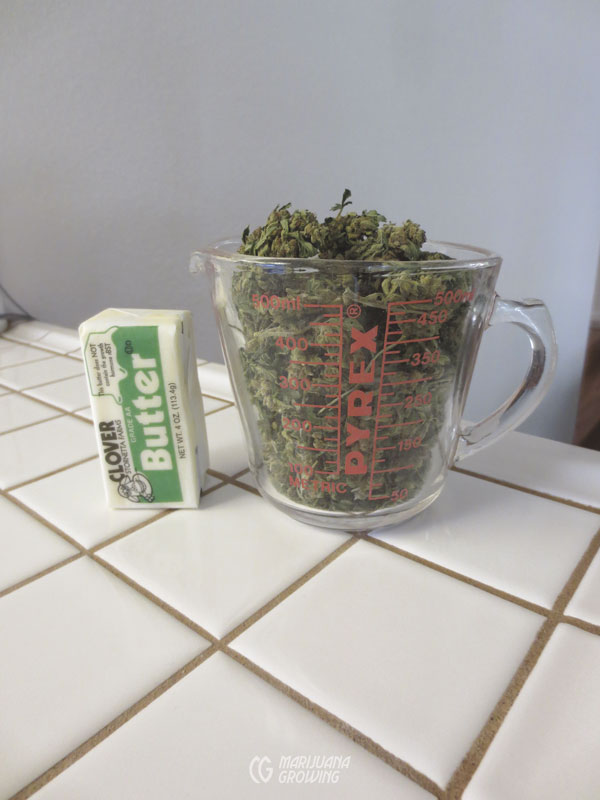
Combine cannabis with butter, vegetable oil, or any fat to liberate cannabinoids.
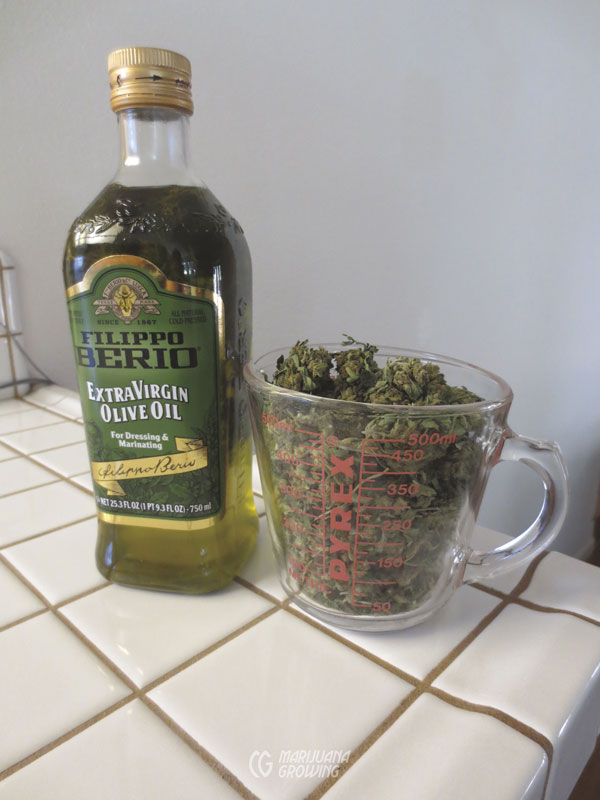
Combine 1 ounce (28 gm) of cannabis with a quart (0.9 L) of vegetable cooking oil to liberate cannabinoids.
Decarboxylation and Solubilization
Raw cannabis is generally non-intoxicating, but may have some psychoactive effects depending on how much free THC is present versus THCA. Patients report that the therapeutic effects of raw cannabis include providing relief from spasticity and inflammation and some reported no therapeutic effect.
Cannabinoids are found in the form of acids (THCA) and attached to the carboxylic group (COOH). It must first be “liberated”; that is, cannabinoids including THC must change from an acid to a nonacid form to become psychoactive.
The process of decarboxylation converts CBD and non-psychoactive THC acid found in raw cannabis to psychoactive nonacid THC. Decarboxylation converts CBD to its nonacid form, which is extremely therapeutic.
The process of solubilization also converts CBD and THC found in dry cannabis from their acid forms to their nonacid forms. Decarboxylation and solubilization achieve the same end but through different processes.
Decarboxylation is a chemical reaction that releases carbon dioxide (CO2). Decarboxylation of cannabis denotes a reaction of carboxylic acids, removing a carbon atom from a carbon chain.
Decarboxylation can be achieved by heating THC-dominant dry cannabis to above 212°F (100°C) or heating CBD-dominant dry cannabis to above 295°F (146°C) for 60 to 90 minutes. Do not heat cannabis – both THC-dominant and CBD-dominant – to above 320°F (160°C) to prevent boiling off cannabinoids. Heating beyond 320°F (160°C) may cause desirable cannabinoids, CBD and THC, to volatize and be lost when they mix with the air.
Decarboxylation also occurs rapidly during vaporization: heating cannabis to 370°F to 380°F (187.8°C–193°C), at which point it vaporizes and the conversion to the “active” nonacidic form takes place. Do not heat above 380°F (193°C) or it may cause preliminary burning/charring. This process frees molecules to convert into carbon dioxide (CO2) and water vapor (H2O).

Smoked or vaporized cannabis that enters the lungs passes directly to the brain via the blood system; the effects are usually felt within 30 to 90 seconds. The dose is easy to control. Decarboxylized and
solubilized cannabis that is eaten passes through the stomach and liver before entering the blood
system. Effects normally appear in 45 to 60 minutes and last up to 12 hours. Dosage is more difficult
to control.
Note: THC is liberated rapidly at temperatures between 370°F to 380°F (187.8°C–193°C), and CBD is liberated rapidly at 370°F to 380°F (187.8°C–193°C). The other 80+ known cannabinoids volatize at different temperatures often lower than 380°F (193°C).
The same decarboxylation process also occurs at a very rapid rate when cannabis combusts (burns). Heat in smoked cannabis causes THC to convert into the psychoactive form. CBD is converted into its nonacid form. Combustion releases many toxic compounds—aromatic hydrocarbons such as benzopyrene and other carcinogens—that are inhaled into the lungs. See www.marijuanagrowing.com for more information.
Cannabinoids are soluble in fats, sugars, and oils (lipids), alcohol, and other oil-based solvents. Once combined, cannabinoids are soluble and convert from the acid to the nonacid form. THC becomes psychoactive, and CBD becomes much more therapeutic.
Solubilization occurs when cannabis is mixed with fats, sugar, oils, alcohol, and other oil-based solvents. The cannabinoids migrate and concentrate in the solvents.
Combine cannabis with these solvents, and heat at low temperatures (122°F–145°F [50°C–62.8°C]) for 60 to 90 minutes to solubilize (extract) cannabinoids. Simmering and stirring ensures that complete extraction occurs.
Combining cannabis with alcohol (spirits or glycerin) requires no heat, but the process takes much longer. For example, place a bud in a bottle of ethyl alcohol—vodka, rum, or spirits of any kind. Over time, the alcohol will take on the flavor and the potency of the cannabis. Or the alcohol can be evaporated to leave a concentrate.
Carbon dioxide (CO2) can also be used as a solvent to liberate cannabinoids. CO2 is becoming a popular method to extract CBD and THC from dry cannabis. See chapter 26, Medicinal Concentrates & Tinctures, for more information.
Safety — Clean Cannabis
Growing your own medicine or purchasing it from a medical cannabis dispensary that tests cannabis for pollutants, molds, and insect residues are excellent options. However, little control is exercised in the marketplace and many dispensaries do not test the cannabis they sell. Wash fresh cannabis with a 0.5 percent solution (see page 122) of hydrogen peroxide (H2O2) to remove surface fungi and pest carcasses, eggs, and feces. Washing dry cannabis requires extra care. Concentrating cannabis in tinctures, kief, hashish, or oils also concentrates pollutants such as pesticides, fungus, and insect residues. Dry plants can be sterilized with UVC light before processing. The UVC light will kill pathogens and insects on the surface of the plant. Only short applications are given to avoid damaging resin with UVC radiation.
Patients susceptible to plant fungi should use only cannabis that is certified to be clean, or grow it at home to ensure purity.
Mold, mildew, and many other fungi can be present inside plant tissue and not visible to the human eye, and even when visible, an untrained gardener will not notice. When minor infections are present, small amounts of mold and mildew can slip into drying containers. Take special care to weed out this infected plant tissue. For example, dry flower buds infected with powdery mildew feel mealy and are easy to crush. They are not firm, and have little substance; instead, they are soft, pliable, and easy to compress.
Heat kills potentially dangerous fungi such as Aspergillus, powdery mildew, and bud mold (Botrytis cinerea). Heating cannabis to 302°F (150°C) for 5 minutes will kill the organisms without degrading THC; other cannabinoids volatize below this temperature. But these temperatures do not degrade or decompose microbial toxins.
Aspergillus, a common household mold, seldom causes harm in humans. However, people with compromised immune systems, AIDS, cancer, asthma, and other diseases can be affected by Aspergillus. Powdery mildew is caused by many species of fungi from the order Erysiphales.
Pesticides and fertilizer residues stay longer on indoor and greenhouse plants than on outdoor plants. Wind, natural sunshine, and rain weather away anything that is applied to leaves. Indoors, degradation of pesticides and fertilizers is much slower. Indoor plants should be watered with pure water for 5 to 6 days before harvest. This rinse will help plants use all the fertilizer in their tissue before harvest. Commercial products are also available to expedite the final leaching and make it more efficient.
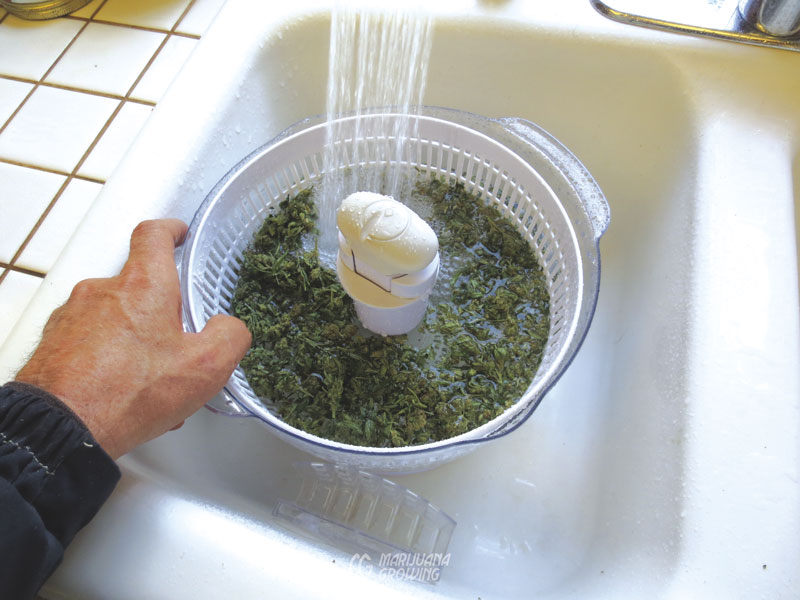
To wash cannabis in H2O2 water before drying, fill a large container with a 0.5 percent solution of hydrogen peroxide. Submerge manicured, bud-filled branches in the container and agitate for 1 to 5 minutes. Fungus and other debris form a thin layer on the surface of the water or, if heavy, sink to the bottom. Use a sponge to skim off the layer of scum. Remove bud-filled branches, rinse and lightly shake water from foliage. Let branches drip dry for 30 minutes in front of an oscillating fan.
Microscopic fungus, dead insects, spider mites, and their eggs and feces stay on plants after harvest. Caterpillar and larvae feces attract fungus that must be cleaned from cannabis. Pests stick to resinous buds and are consumed by patients. Cooking alone is not enough to destroy bacteria, fungi, pest carcasses, eggs, and feces.
Here is a short list of laboratories that can test for contaminants of medicinal cannabis in California:
Pure Analytics, http://pureanalytics.net/
Steep Hill Halent Laboratories, Inc., http://steephilllab.com/
The Werc Shop, http://thewercshop.com/
Cooking with fresh cannabis is not always possible; dry cannabis is usually all that is available. Keep dry cannabis in an airtight container in a cool, dark place to maintain minimal preservation of active ingredients, cannabinoids. See “Storage” in chapter 9, Harvest.
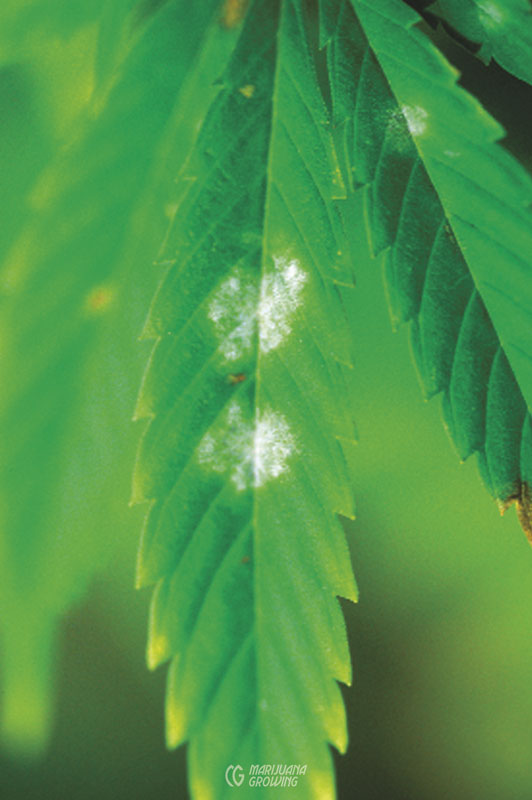
Diseased and desiccated foliage should be removed and discarded. Do not consume it. Foliage with nutrient deficiencies is okay to use, but it may have lower levels of cannabinoids.
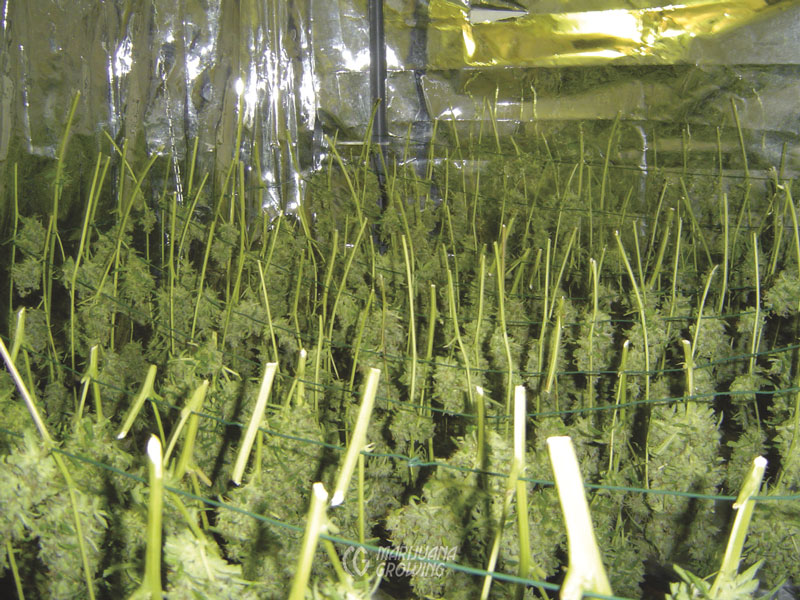
Cannabis roots contain no cannabinoids, but little is known as to their therapeutic effects. Roots are recycled back into the garden or compost.
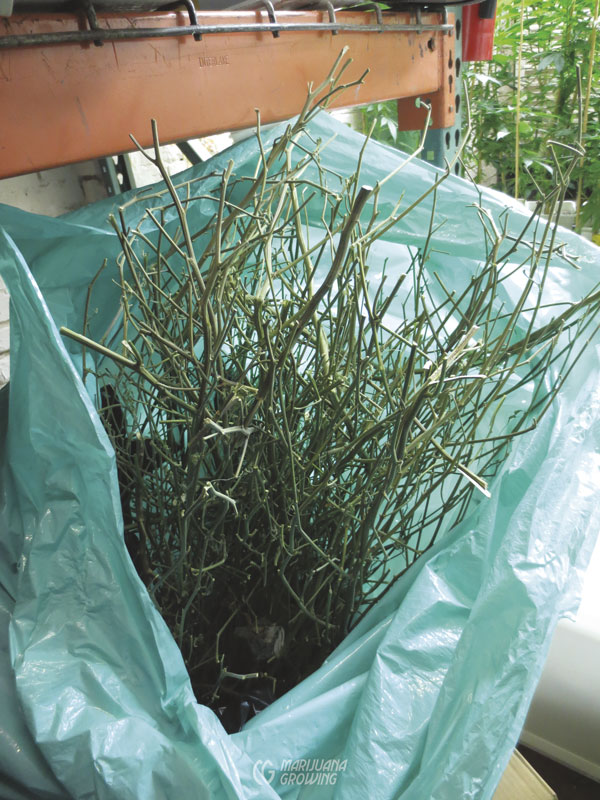
Stems have little or no cannabinoid content. After harvest, small buds and foliage may remain on stems. Separate stems from leaves and small buds. Do not add stems to recipes. Stems make good compost when chopped.
Grades of Cannabis
Cooking with kief, hash, or oil instead of flower buds or leaf has many benefits.
Cannabis leaves and buds are in their acid form and not decarboxylized. The cooking process must perform the decarboxylation, and most often it is inefficient. Consistent dosage and no “green” flakes or taste are other strong reasons to use only cannabis concentrated in fats, oils, and alcohols. Water hash is most economical, and since many terpenes are already gone, heating while cooking does not destroy more flavors.
Hemp is industrial-grade cannabis that is often used for its fiber, seed, and oil. Hemp has low levels of THC and, most often, other cannabinoids. Hemp is an ingredient in many balms, lotions, and soaps. Hemp fiber is used to make clothing and rope along with new products such as cannabis bedding for animals.
Large leaves are separated at harvest. Dry leaves in a paper bag, turning every day by hand. Leaves have low cannabinoid content. Large, older leaves near the bottom of plants contain fewer cannabinoids than those located further up. Remove leaf stems before grinding or adding to recipes. Often large quantities of large leaves must be added to achieve therapeutic effects. Discard brown or discolored leaves.
Small leaves are located higher on the plant and around flower buds. Resin is often visible on these “trim” leaves that are packed with cannabinoids. Small leaves without visible resin, or recently formed and immature leaves contain fewer cannabinoids. Remove leaf stems. Chop fresh leaves and grind or chop dry leaves before adding to fats, oils, and alcohols.
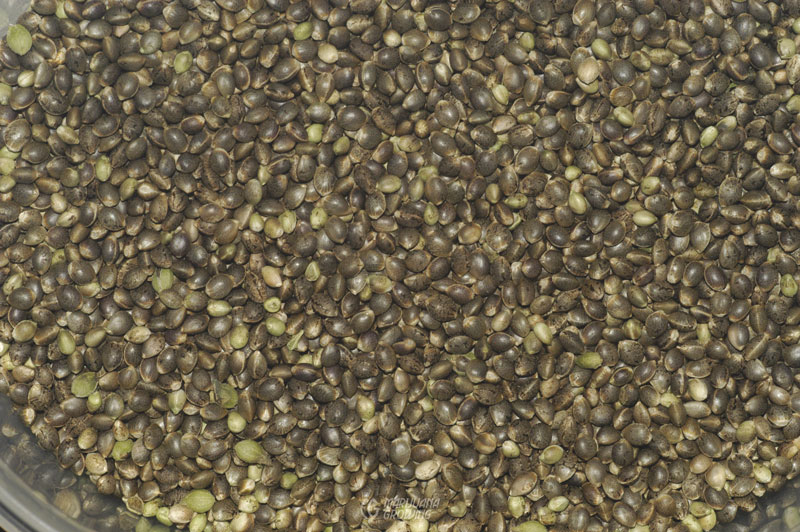
Seeds are rich in oil and omega-3. Find hemp seeds in bulk by searching “hemp seeds bulk” on www.google.com. Sometimes you can find hemp seeds from China, where they grow varieties that produce huge seeds.

Large leaves contain low levels of potent cannabinoids.
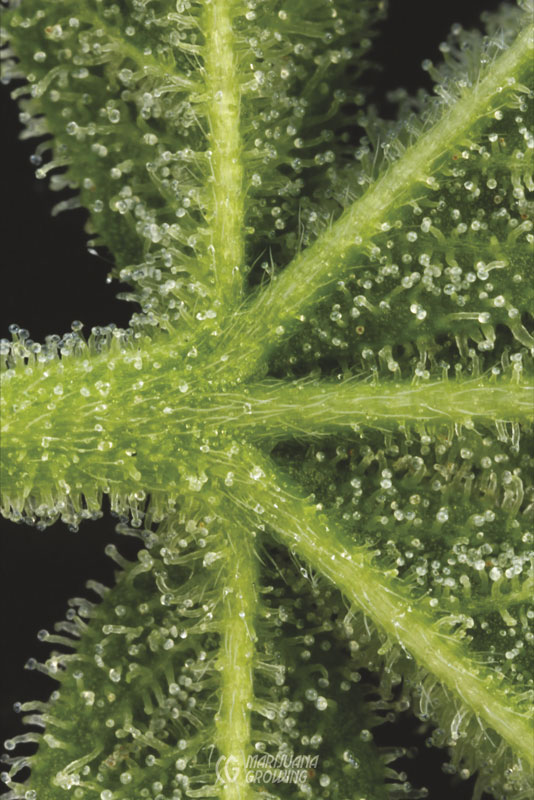
Small leaves around flower buds are often glistening with resin and make excellent hashish and tinctures for cooking. (MF)
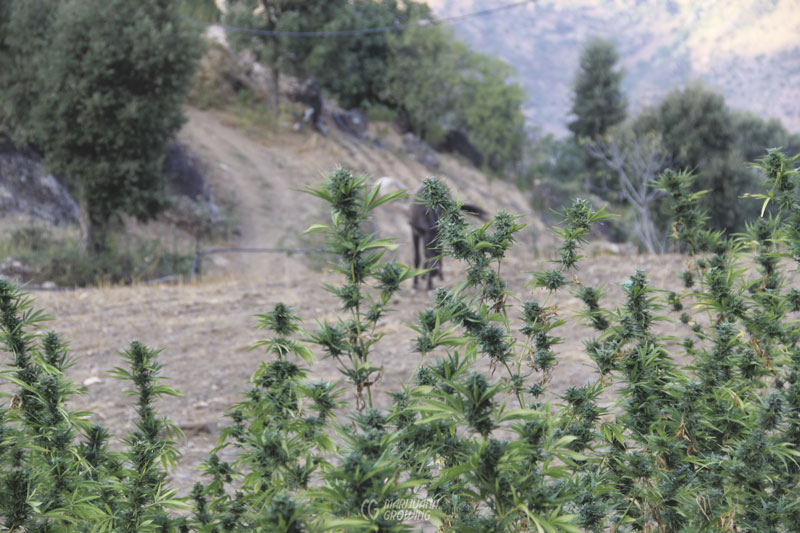
Flower buds, the most resinous part of cannabis plants, are often small and lightweight but still contain high levels of cannabinoids. Chop fresh flower buds. Chop or grind dry flower buds before adding to fats, oils, and alcohols.
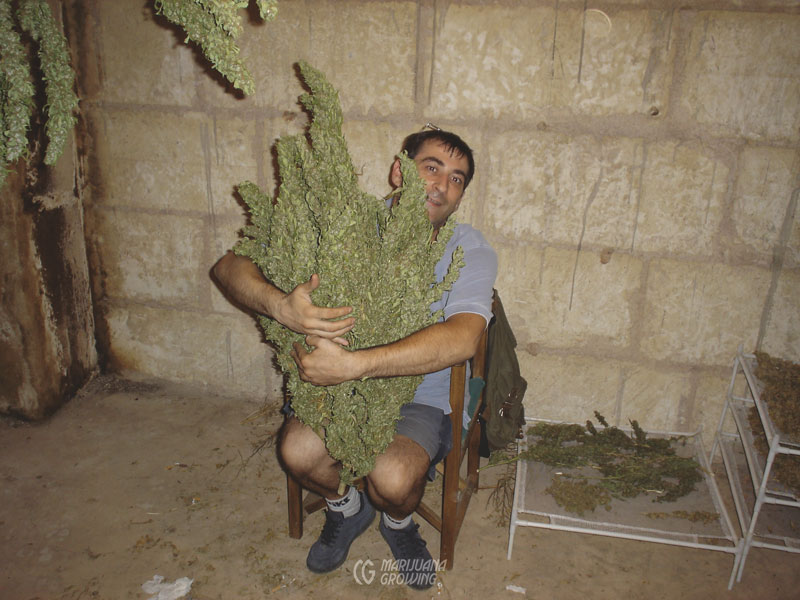
Large flower buds are often loaded with visible cannabinoid-rich resin. We advise people to use high-quality buds for cooking. Large flower buds are often submerged in cooking and salad oils or bottles of spirits.
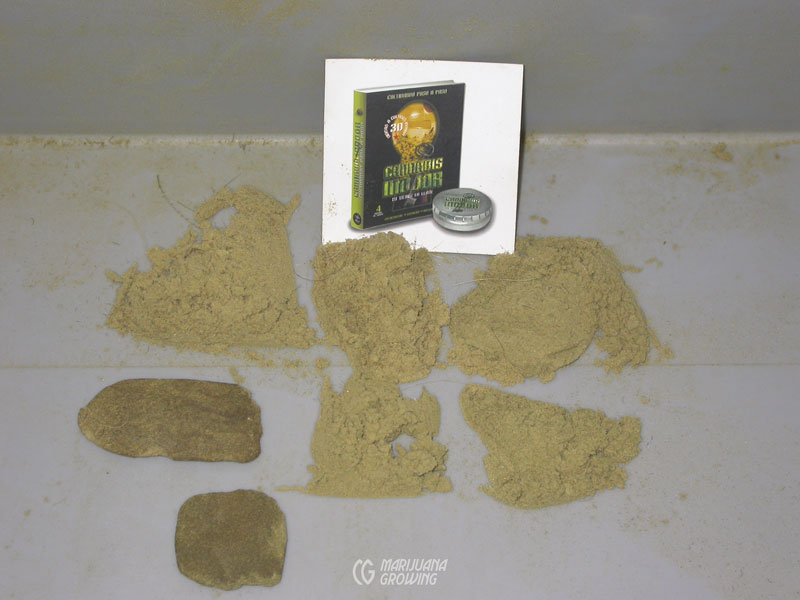
Kief (also known as keef or kif), the raw resin glands that fall from buds and leaves, is collected. It is usually adulterated with small amounts of foliage and debris from the garden. Kief is best used when added directly to fats, oils, and alcohols.
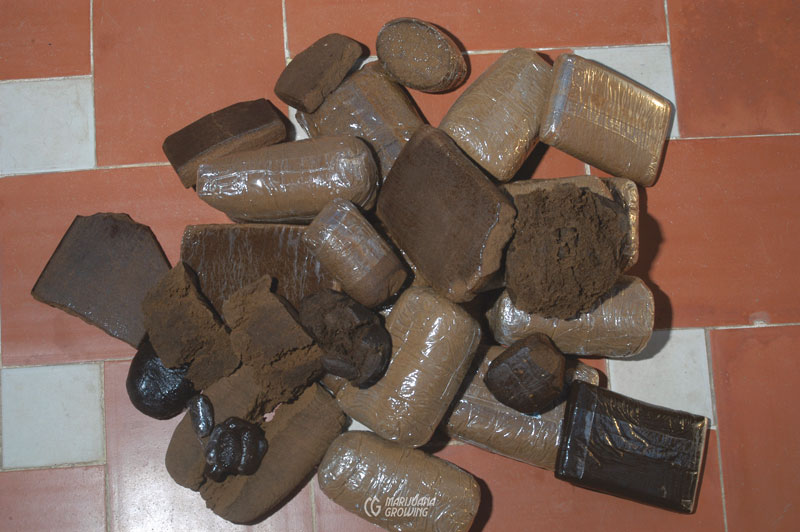
Hashish (aka hash) is concentrated, compressed resin glands (kief). Hashish must be broken into small pieces or ground before adding to fats, oils, and alcohols.
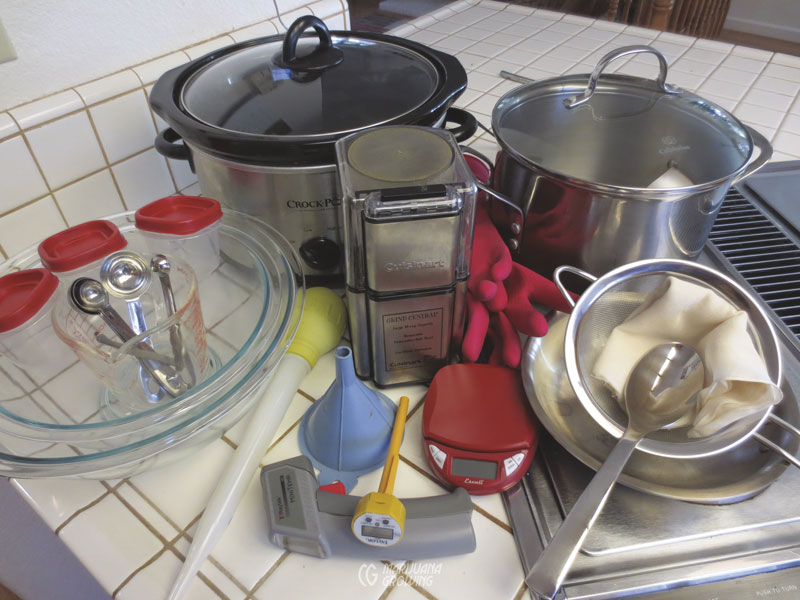
Here are the basic utensils you will need to make most medicinal cannabis concentrates.
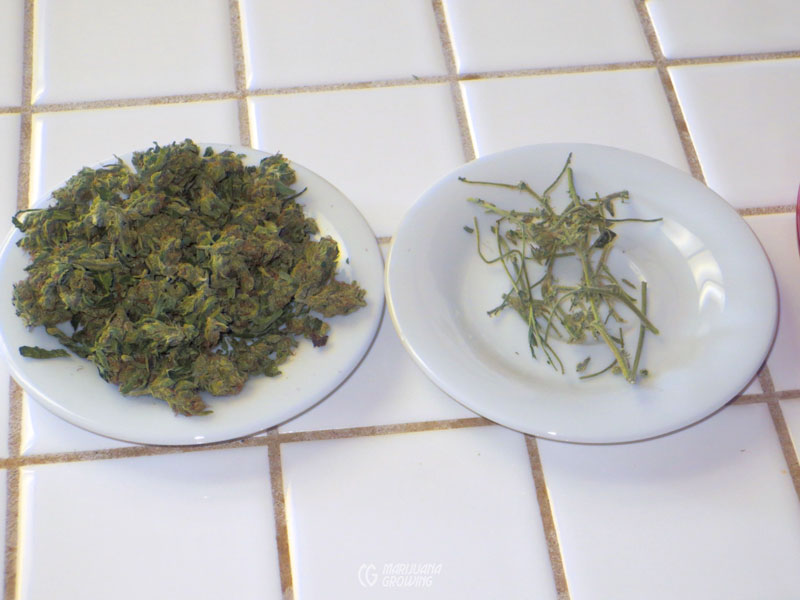
Remove all stems and small leaf debris from manicured buds before making concentrates.
Temperature and Volatility
Temperature and Volatility known cannabinoids volatize at lower temperatures. See chapter 2, Measuring Cannabinoids, for more information on the boiling point of specific cannabinoids.
Baking and cooking require a heat source that is easy to control so that high temperatures do not cook out beneficial elements. Temperatures are easiest to control quickly with a gas stove or oven. Electric burners often heat and cool slowly. However, a hot plate is a convenient source of heat that can be plugged in anywhere. If you use recipes that heat beyond 300°F (148.9°C), calibrate with an accurate thermometer to avoid volatizing cannabinoids.
NOTE: To avoid destroying cannabinoids, do not bake cannabis recipes at more than 350°F (176.7°C).
- Low heat = 200°F (93.3°C)
- Medium heat = 250°F–275°C (121.1°F–135°C)
- High heat = 300°F–350°F (148.9°C–176.7°C)
Utensils
Use Pyrex glass, ceramic, or stainless steel utensils when following these recipes.
A Crock-Pot is a stand-alone electric cooker that supplies low, even heat. A removable ceramic liner is very practical to simmer cannabis recipes for hours. The liner can be removed for cleaning, and it can be placed in the refrigerator or freezer separate from the heating element of the Crock-Pot. This versatility saves the space and hassle of using a separate container.
| CONVERSION SCALE | |
|---|---|
| Standard Measurement | Centiliters |
| 1 teaspoon (tsp) | 0.5 |
| 1 tablespoon (tbsp) | 1.5 |
| 1 cup (c) | 23.7 |
| 1 pint (pt) | 23.7 |
| 1 pint (pt) | 94.6 |
| 1 pint (pt) | 3 |
A double boiler is an alternative to a Crock-Pot. It consists of a small cooking pot suspended inside of a larger container. Water boils in the larger container and heats the contents to be cooked in the smaller container. The temperature is relatively easy to control, and the possibility of burning the recipe is next to nil.
List of utensils for basic recipes:
• 2 large bowls
• measuring cup
• measuring spoons
• scale to weigh dry measure
• blender to pulverize cannabis
• sifter/sieve
• strainer
• saucepans
• large cooking pot with a lid
• Crock-Pot
• cheesecloth
• string or large rubber bands
• large spoon (can be wooden)
• ladle
• thermometer, accurate to within 5oF (3oC)
• funnel
• rubber gloves
• plastic storage containers with lids
Cooking with Cannabis
Smoke Points
- butter: 250°F–300°F (121.1°C–148.9°C)
- olive oil: 375°F–475°F (190.6°C–246.1°C)
- peanut oil (refined): 450°F (232.2°C)
- sunflower oil (refined): 440°F (226.7°C)
Cannabis butter is a main ingredient in many recipes. It can be used alone, as butter on bread, or mixed into countless recipes. Cannabinoids are bound to milk fats in butter and are preserved as long as butter is safe to consume. Use salted butter for most recipes; it has a higher smoke point than unsalted. Use unsalted butter for baking. Slow, even cooking at a low temperature and adequate stirring are essential to avoid burning when making cannabis butter.
Quick Cannabis Butter
Process small amounts of cannabis butter, less than 2.2 pounds (997.9 gm) of cannabis butter by sautéing it in a pan and adding cannabis. Process larger amounts of cannabis with the recipe that follows:
Utensils
- coffee grinder or food processor
- 2 saucepans
- strainer
- cheesecloth
Ingredients
- 0.25 oz (7.1 gm) finely manicured
cannabis flower buds - 1 stick (0.5 c [23.7 cl]) butter
Quick Cannabis Butter: Step-by-Step

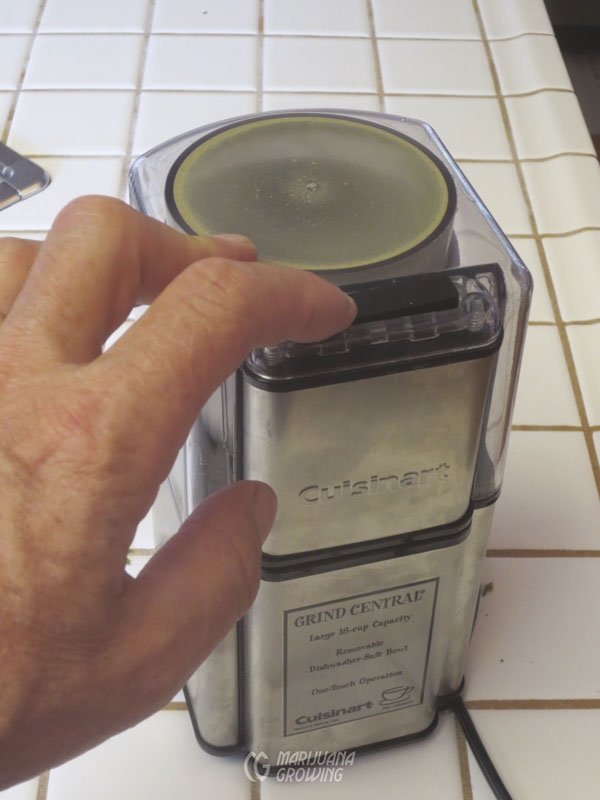
Step One: Chop cannabis flower buds in a small coffee grinder (or food processor). Make sure the coffee grinder is clean and used only for cannabis. Chopped flower buds release cannabinoids into the butter faster.
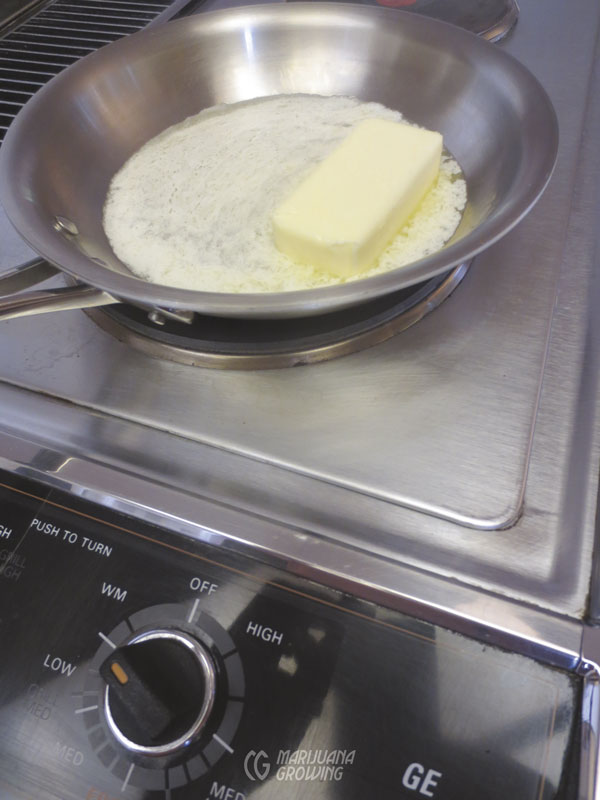
Step Two: Melt the butter on low heat.
Step Three: Once the butter has melted, add the chopped cannabis.
Step Four: Let the butter and cannabis mix simmer for about 45 minutes, stirring every few minutes, which mixes cannabinoid and butter molecules and speeds absorption.
Step Five: Filter butter and cannabis through a cheesecloth-lined strainer. Wait until the mix has cooled enough to handle, and then wear rubber gloves to squeeze residual liquid from cheesecloth.
Quick Cannabis Butter: Step-by-Step (cont’d)
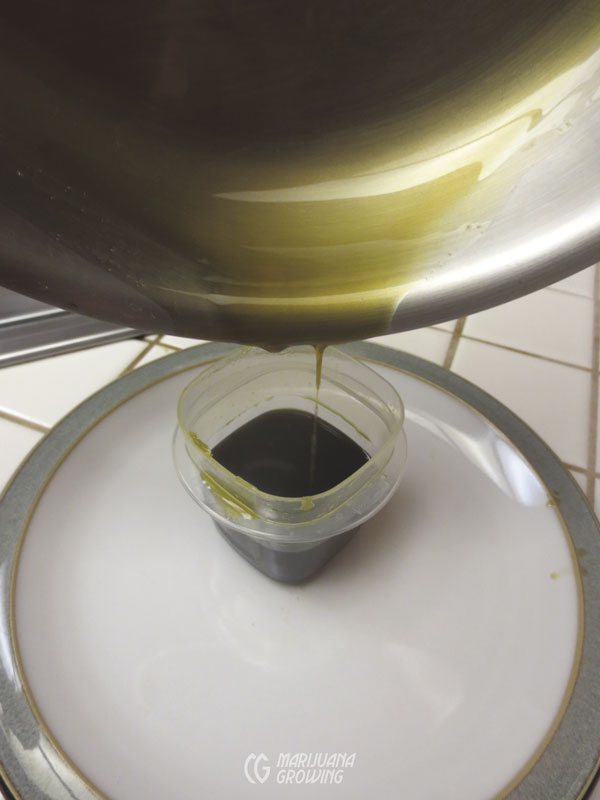
Step Six: Pour the cooled, filtered liquid into a storage container.
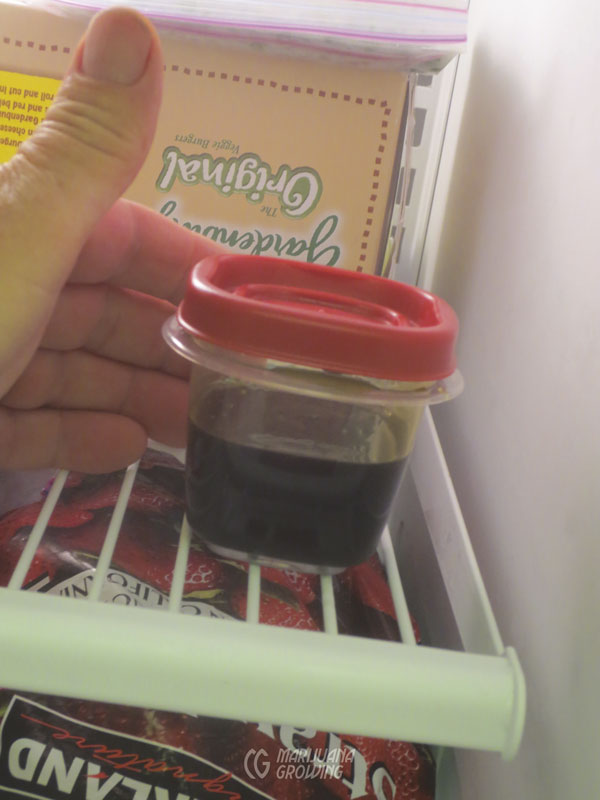
Step Seven: Refrigerate the liquid until solid.
Cannabis butter is green because milk fat takes on green plant molecules and cannabinoid molecules. The taste of green cannabis is objectionable to most people. Here are some quick, easy recipes to disguise the taste of cannabis in butter.
Basil Butter: Add a minced clove of fresh garlic and 0.5 cups (11.8 cl) of fresh chopped basil to every 0.5 cups (11.8 cl) of butter. Great garnish for chicken or fish.
Cilantro Lime Butter: Add 3 tablespoons (4.4 cl) chopped cilantro and two 3 teaspoons (1.5 cl) of lime juice to every 0.5 cups (11.8 cl) of butter. You can spice it up with a dash of hot sauce, too!
Garlic Butter: Mince 1 clove of garlic and combine with 0.5 cups (11.8 cl) butter. Use the butter on garlic bread and meat dishes. Chop up some parsley to add more flavor.
Lemon Butter: Add 1 teaspoon (0.5 cl) fresh lemon juice and 1 tablespoon grated lemon peel to 0.5 cups (11.8 cl) of butter. Pour it on chicken, fish, or my favorite, grilled asparagus.
Blue Cheese Butter: Add 2 ounces (56.7 gm) blue cheese to 0.5 cups (11.8 cl) of butter. Include minced chives or shallots, rosemary, or thyme.
Clarified Cannabis Butter (Ghee)
Clarified butter (aka drawn butter, ghee, or samna) has a longer shelf life than cannabis butter and a higher smoke point, which makes it desirable for sautéing, basting seafood, and numerous recipes. A certain percentage of butter is lost to friction, to butter that remains in the saucepan, and to contaminants in the clarifying process. However, clarified butter has negligible amounts of lactose and is acceptable for most lactose-intolerant consumers.
Avoid “green” taste by using concentrated cannabis resin that contains little plant material. Clarified butter made from good kief has little objectionable foliage and contaminant residues which helps exclude the foliage taste.
Utensils
- saucepan or double boiler
- spoon
- measuring cup
- scale
- strainer
- cheesecloth
- airtight storage containers
Utensils
- saucepan or double boiler
- spoon
- measuring cup
- scale
- strainer
- cheesecloth
- airtight storage containers
Time to prepare: 30 minutes
Cooking time: Cooking time at 150oF to 200oF (65.6oC–93.3oC)
Clarified Cannabis Butter (Ghee): Step-by-Step
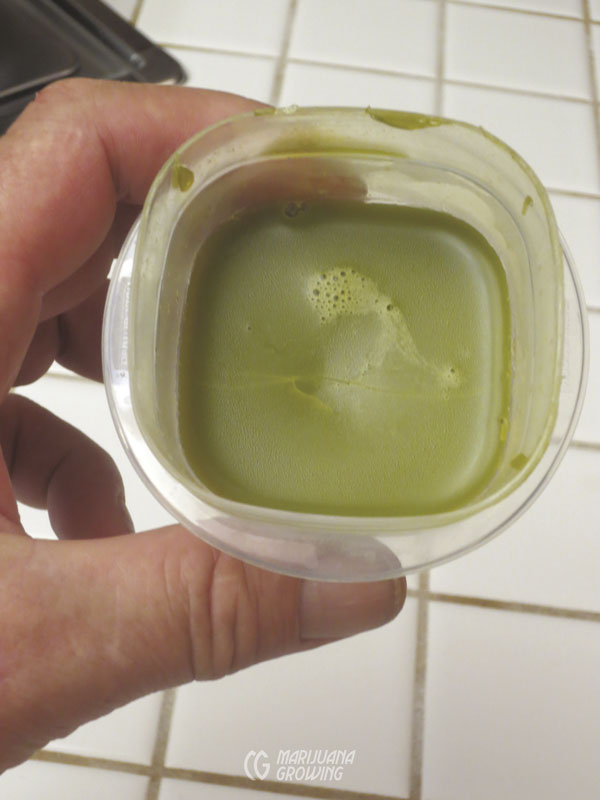
Step One: Follow instructions to make Cannabis Butter, above.
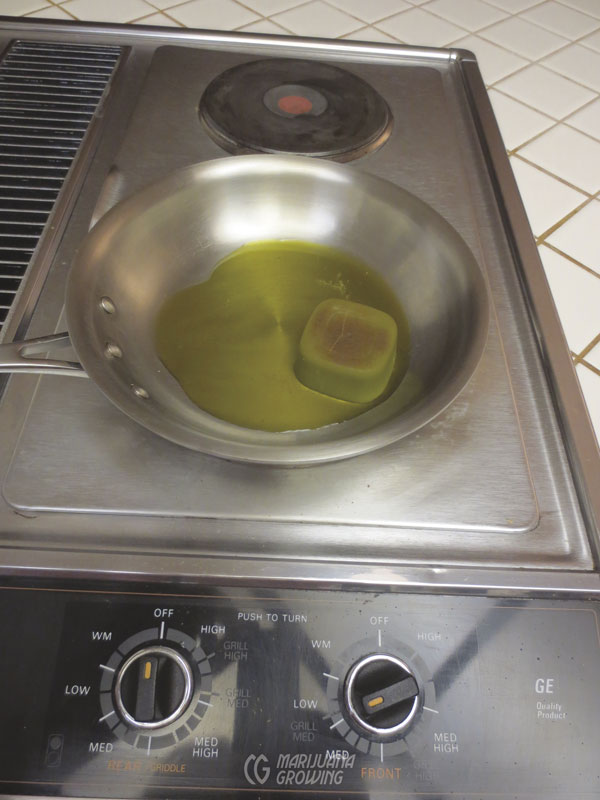
Step Two: Melt cannabis butter in a pan or double boiler at low heat. Do not boil.
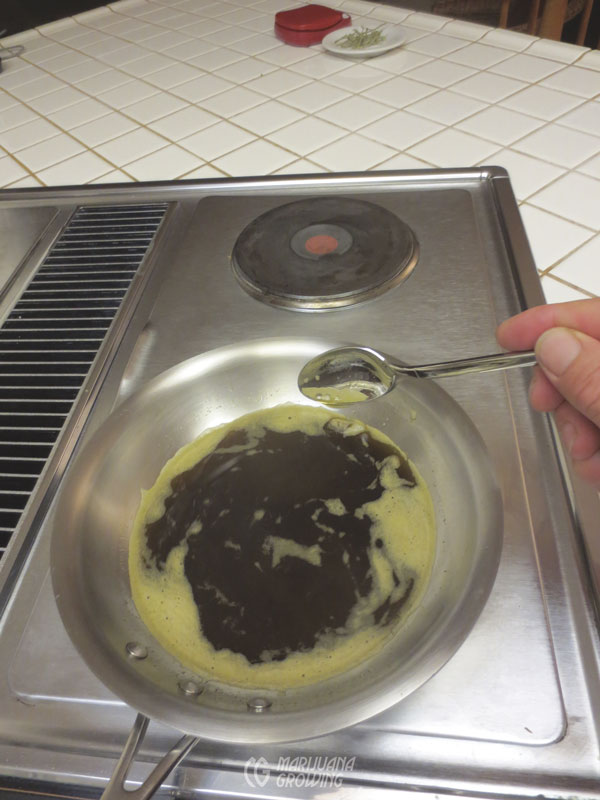
Step Three: Simmer butter for 30 minutes, stirring regularly.
A bubbly froth may come to the top during Step Three, but if the butter was filtered with cheesecloth, much less froth develops. Skim froth and scum that forms on surface. It thins slowly and the color of the butter changes to deep green. Continue simmering until butter turns greenish-golden color. The green tint will always remain. Residues settle on the bottom and the clarified cannabis butter is a translucent golden color with a deep, rich fragrance.
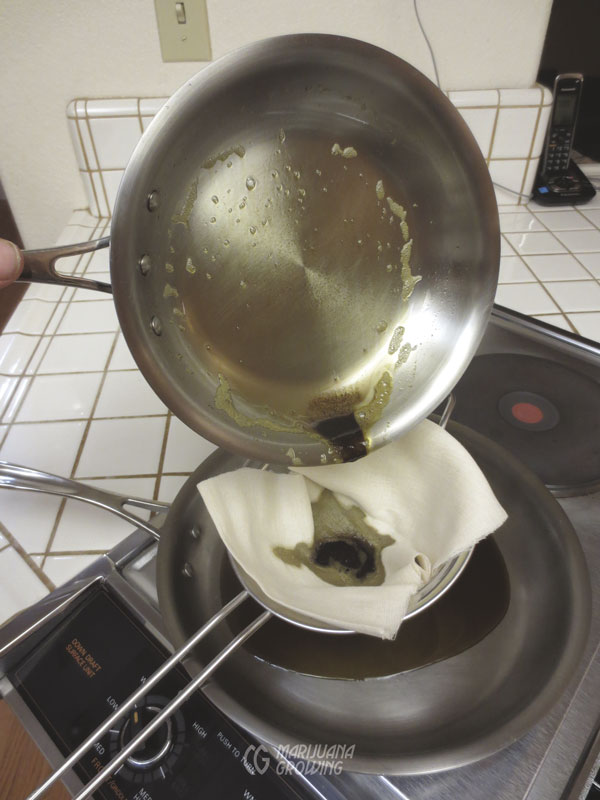
Step Four: Pour the liquid butter through a strainer lined with two layers of cheesecloth. Ball up and push the cheesecloth containing residuals against the strainer to exude all remaining butter into a warmed saucepan below.
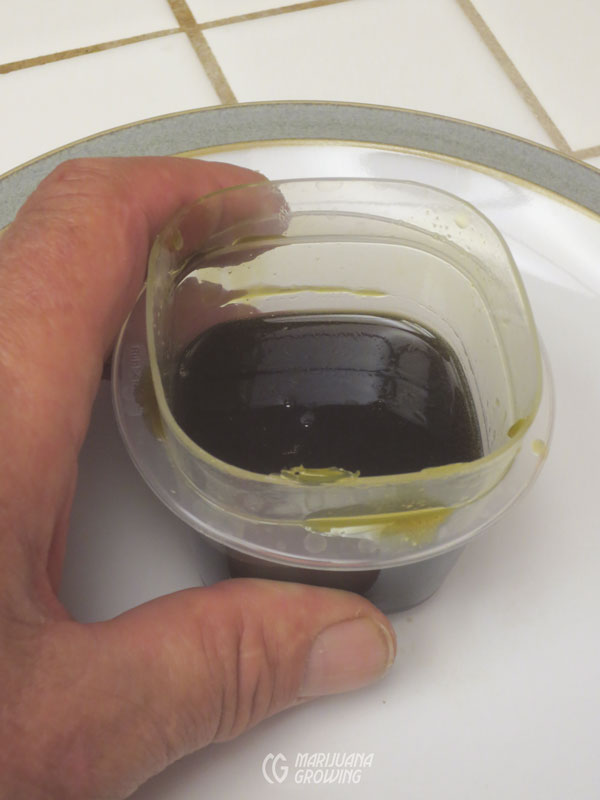
Step Five: Pour the clarified butter into a receptacle.
Note that the clarification process removed a volume of butter. The “freeze line” from cannabis butter can be seen above the butter’s surface.
Ghee: Step-by-Step (cont’d)
Step Six: Store clarified cannabis butter in airtight containers in the freezer or refrigerator. It will last up to a year or longer in the freezer and several months in a refrigerator. Bathing butter in water extends shelf life.
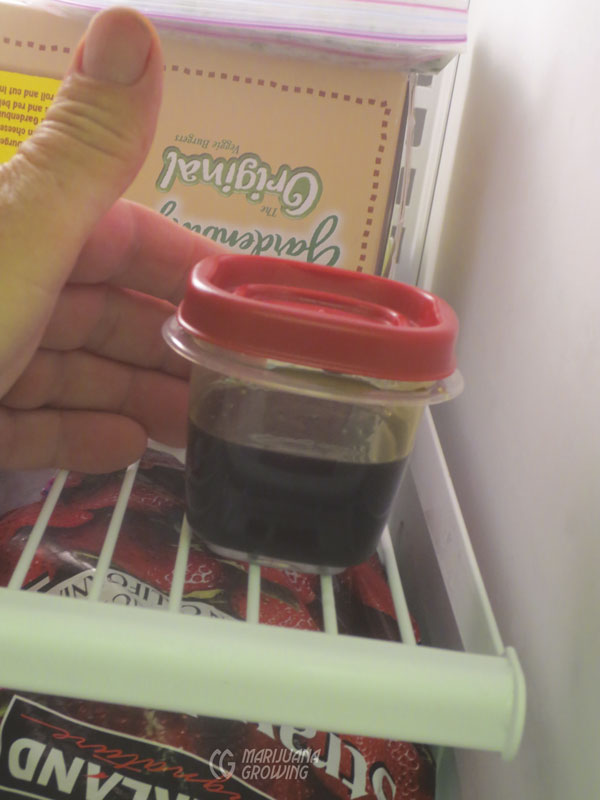
Cannabis Butter (2.2 pound [1 kg] plus)
This recipe requires separating water from butter and is best used to process several pounds (kg) or more of cannabis butter.
You will need a couple of days to make this recipe, but the process is low maintenance and easy to follow. In fact, you can follow instructions for making “Cannabis Coconut Oil,” at right. Simply substitute the same quantity of butter and cannabis.
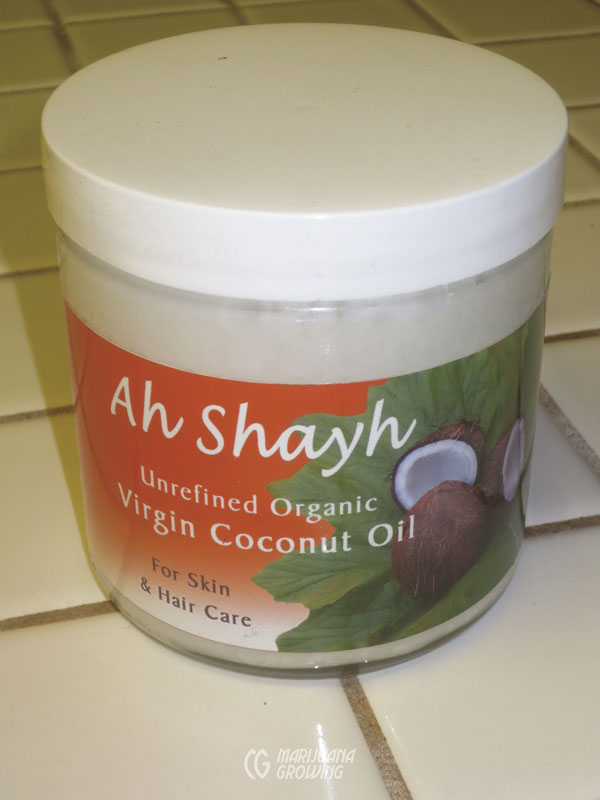
Cannabis Coconut Oil
Coconut oil, a healthy saturated fat, absorbs the maximum amount of cannabinoids. Coconut oil is solid at room temperature; if semiliquid, a half hour in the freezer will solidify it. Coconut oil (unrefined) has a higher smoke point (350oF [176.7oC]) than butter. (It can also be used for skin salves and creams, as well as be put into capsules.) Coconut oil can be used in many recipes as a substitute for vegetable oil or butter.
Utensils
- large pot
- 1 qt (1 L) water
- spoon
- container to store cannabiscoco-butter
Ingredients
- 16 oz (453.6 gm) organic coconut oil
- 1oz (28.3 gm) cannabis flower buds
Cannabis Coconut Oil: Step-by-Step
Step One: Boil one quart (1 L) of water in a large pot.
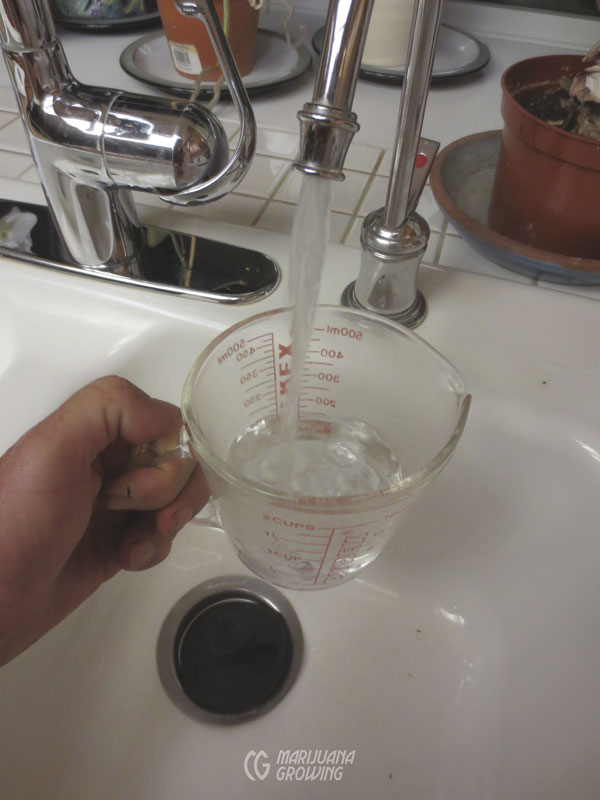
Step Two: Add 1 ounce (28.3 gm) of manicured cannabis flower buds.
Cannabis Coconut Oil: Step-by-Step (cont’d)
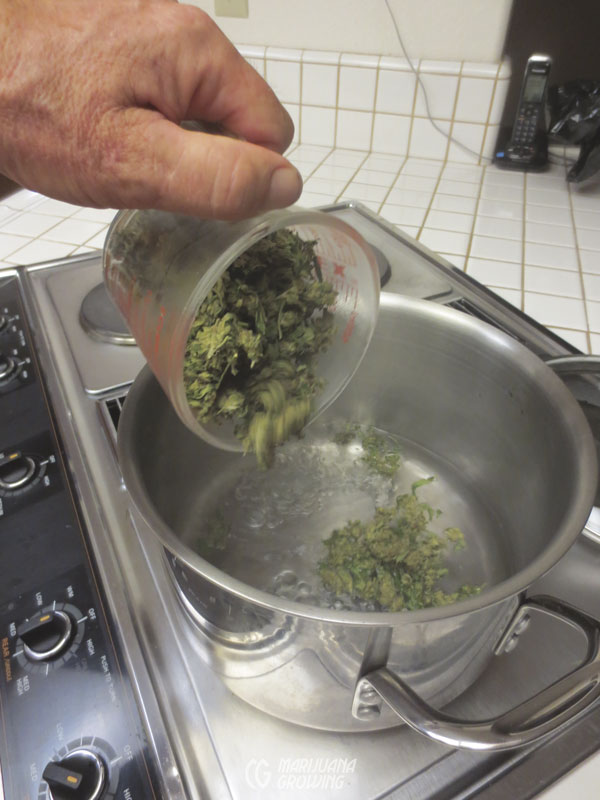
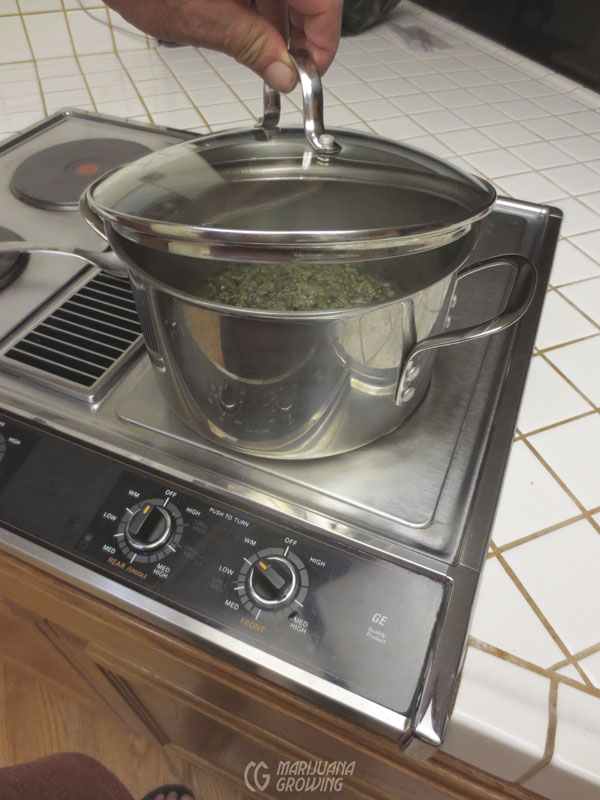
Let simmer and stir during the next hour.
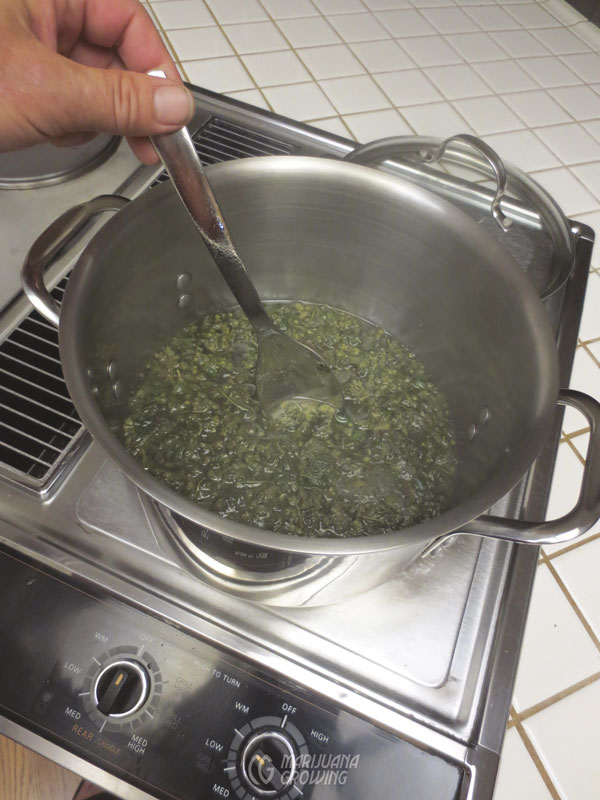
Remove the lid and stir regularly.
Step Three: Add 16 ounces (47.3 cl) coconut oil kept at room temperature to the hot water/cannabis mix.
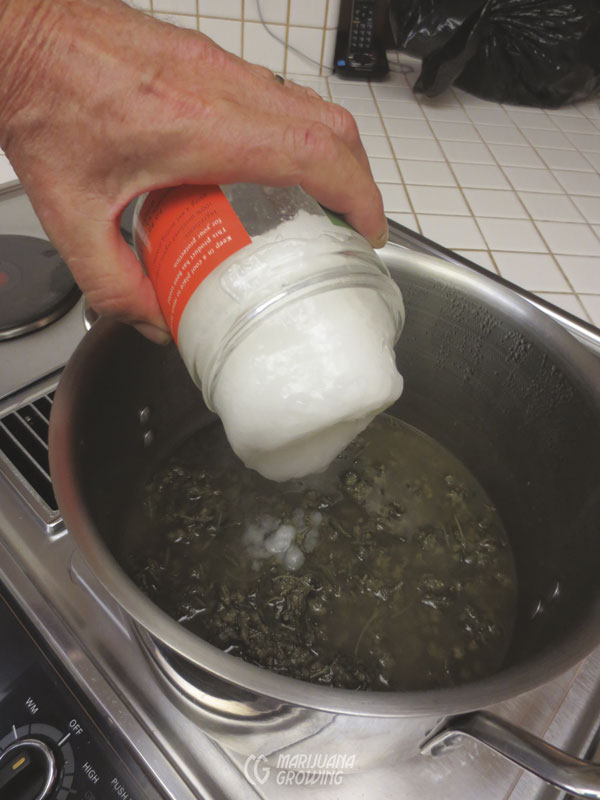
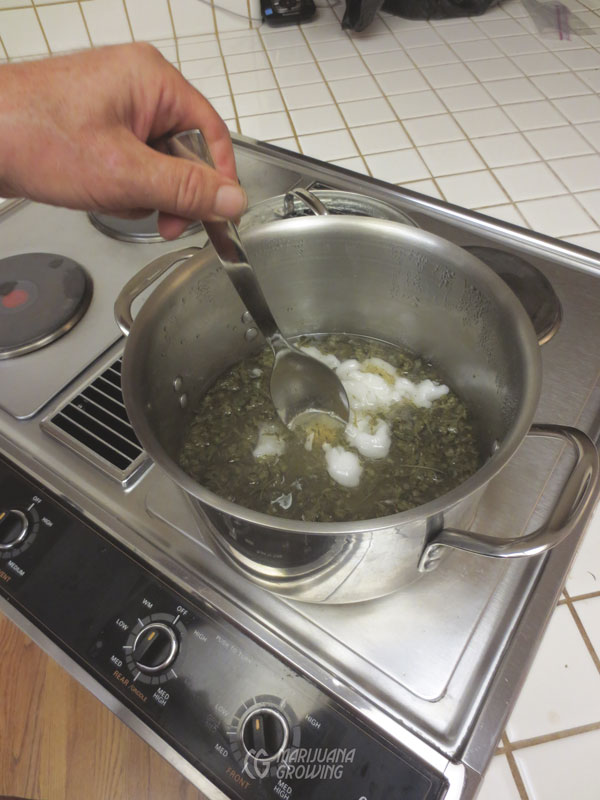
Stir in coconut oil for at least a minute to ensure that it is well mixed.
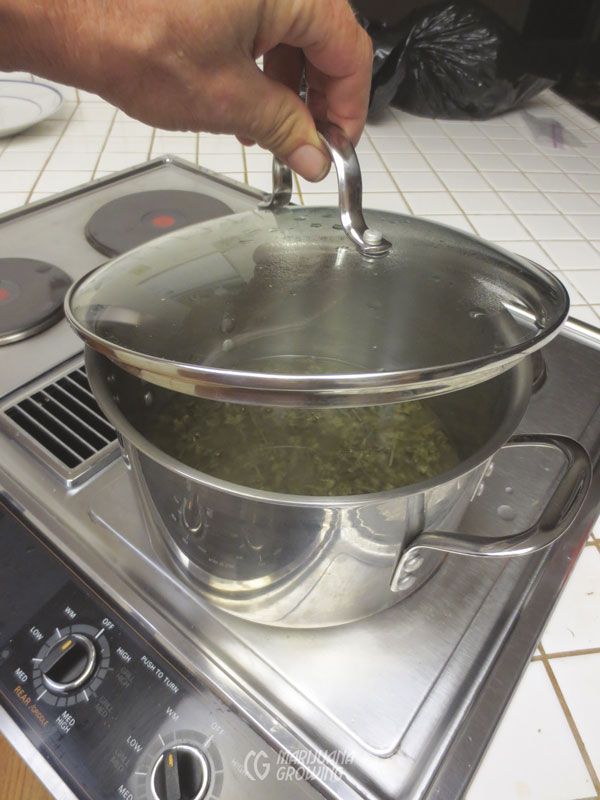
Cover and continue simmering for 10 minutes.
Cannabis Coconut Oil: Step-by-Step (cont’d)
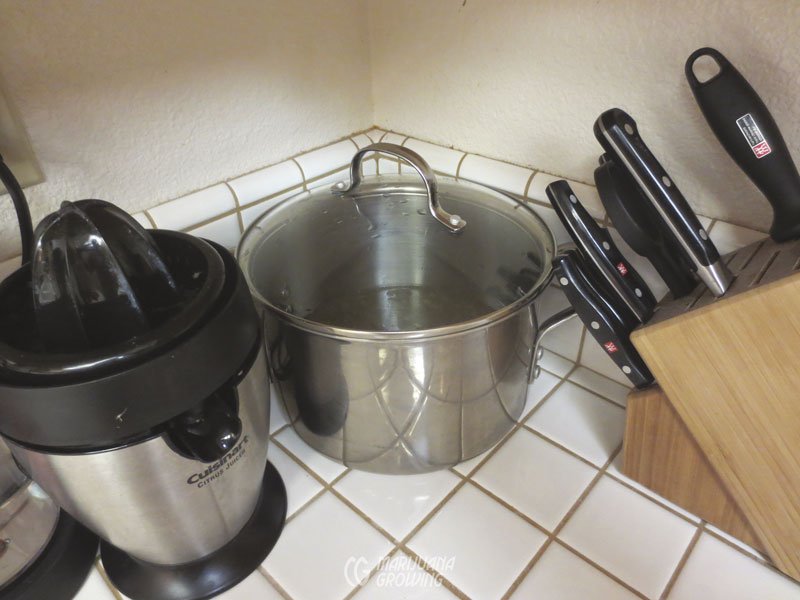
Step Four: Remove from heat. Set aside for two days so that more cannabinoids can be absorbed by the coconut oil.
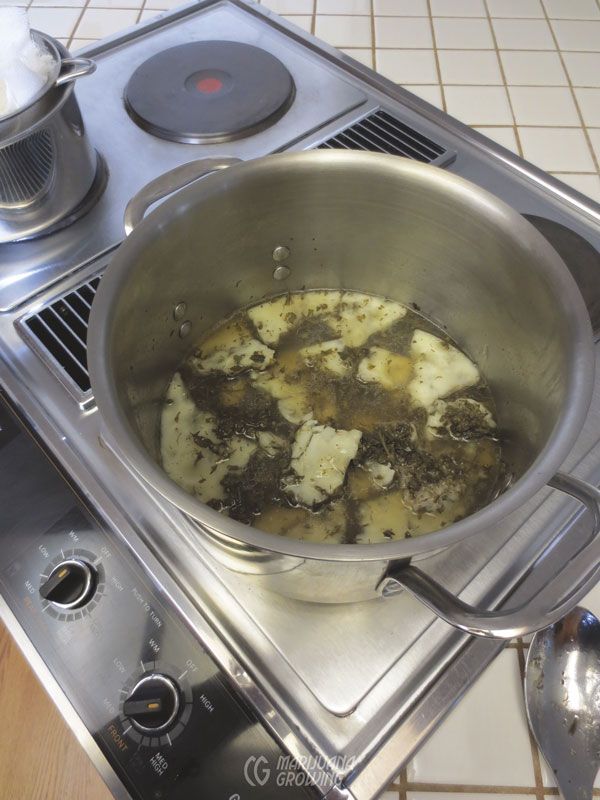
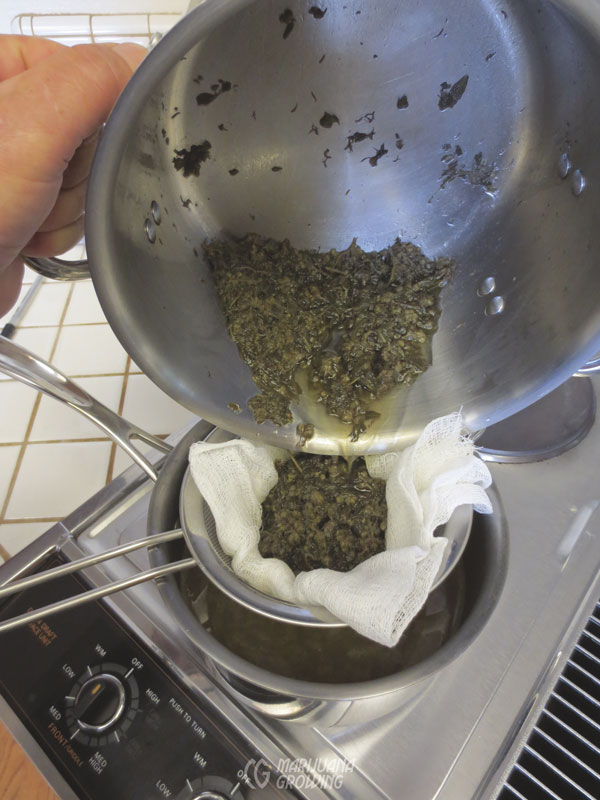
Step Five: Set the pot on the stove and bring to a simmer so that all the coconut oil is dissolved.

Step Six: Pour the mix through a strainer and cheesecloth. Let cool. Wear rubber gloves and squeeze the cooled cannabis/coconut oil mix so that all the liquid comes out.
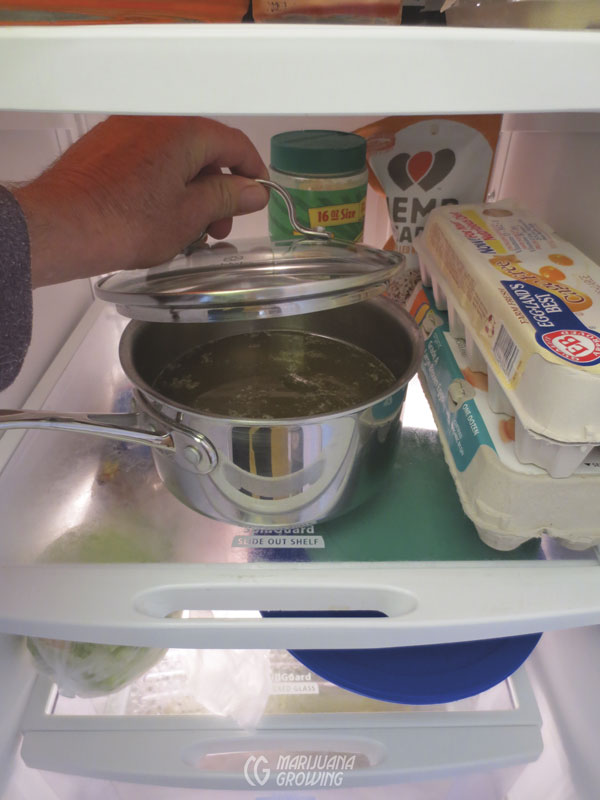
Step Seven: Refrigerate the mix overnight so that the water and coconut oil separate. Remove the pot and pour off water. Retain solidified coconut oil.
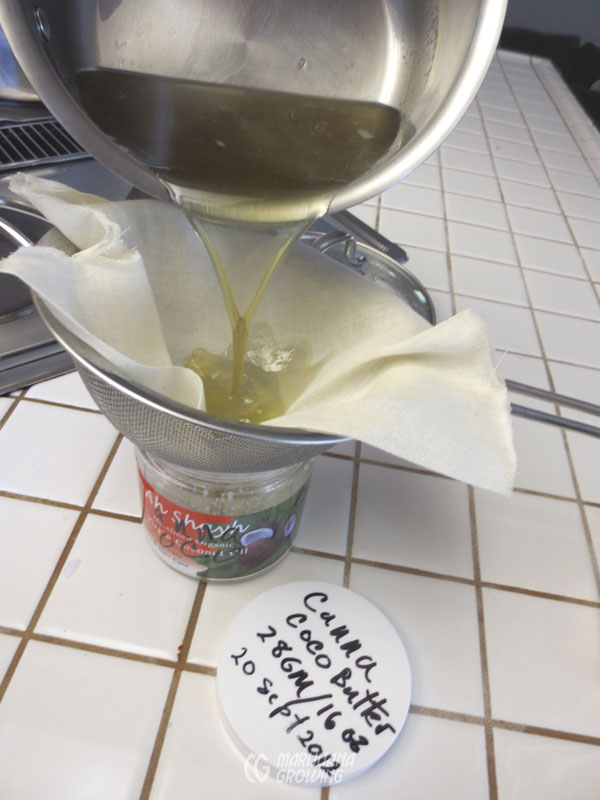
Step Eight: Heat solidified coconut oil in a saucepan until liquid. Pour into small containers with lids for storage. Place in refrigerator to store.
Cannabis Vegetable Oil: Step-by-Step
Cannabis Vegetable (Olive) Oil
Choose your preferred vegetable oil—olive, canola, sunflower, flaxseed, grape seed, etc.—to use in this recipe. Notice that different oils react differently to heat. For example, the smoke point of olive oil is 375oF–475oF (190.6oC–246.1oC), the smoke point of peanut oil (refined) is 450oF (232.2oC), and the smoke point of sunflower oil (refined) is 440oF (226.7oC). This should make little difference at low heat levels. If using my favorite, olive oil, always purchase extra virgin (first cold press) to ensure the highest quality. Avoid using bland oils such as canola with little taste. Always use gloves to avoid contamination.
Vegetable oils must be placed in the freezer for several hours and frozen to become solid.
The first method is not as efficient as the second, but it is much easier.
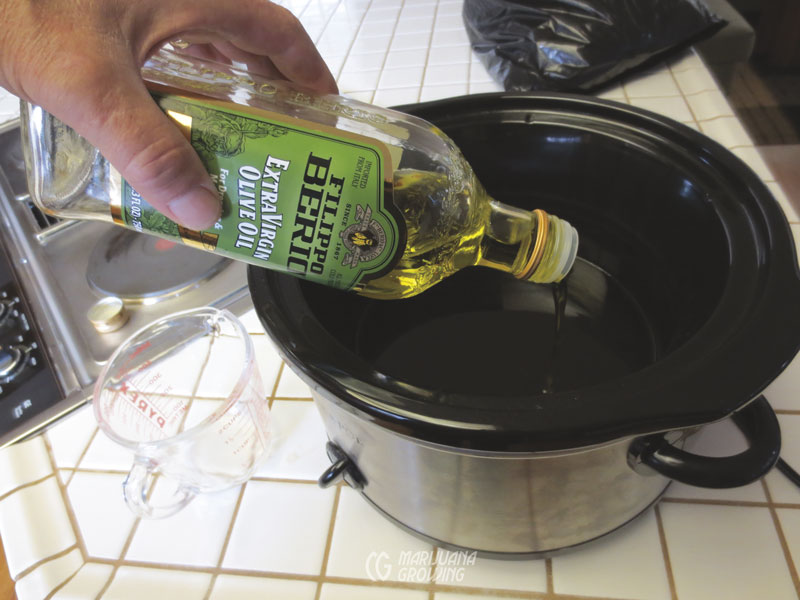
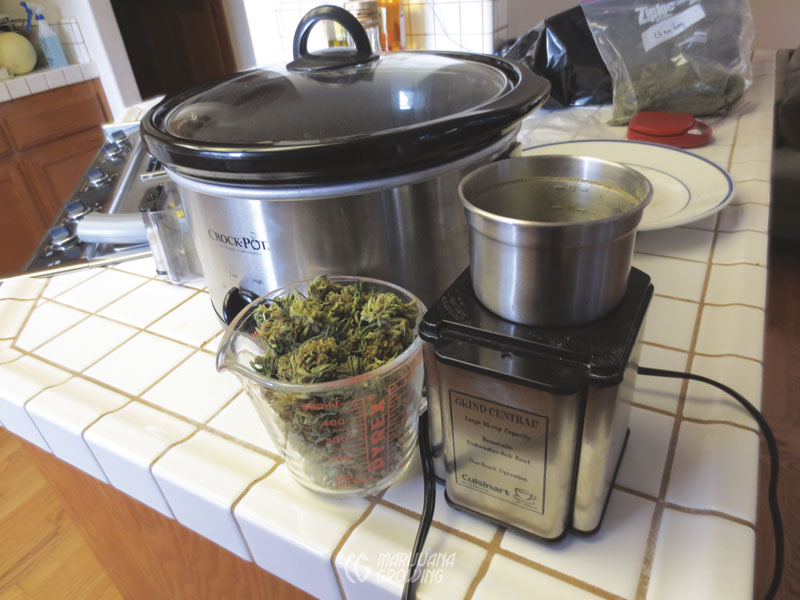
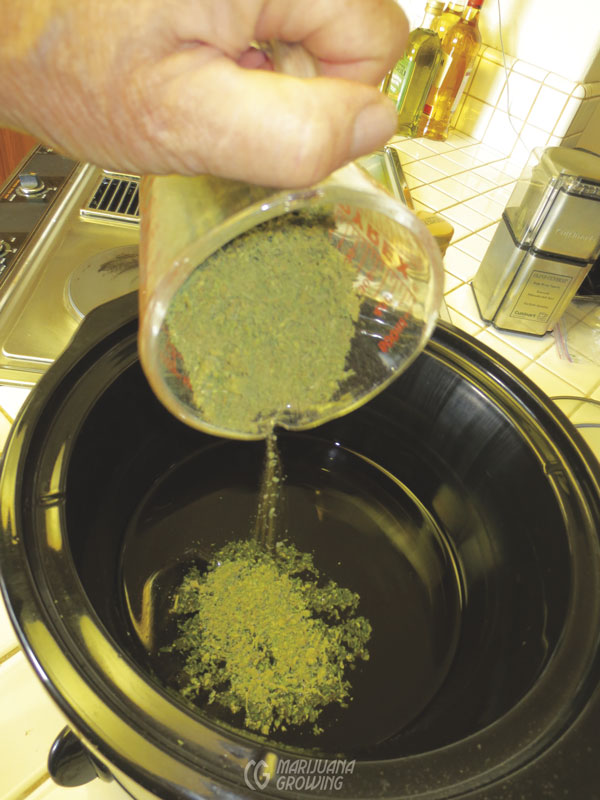
Step One: Use a Crock-Pot to heat 4 cups (94.6 cl) of olive oil. When it reaches 150oF (65.6oC) add 1 ounce (28.3 gm) dry, manicured cannabis flower buds. Add buds slowly so that they are sure to be permeated with hot oil.
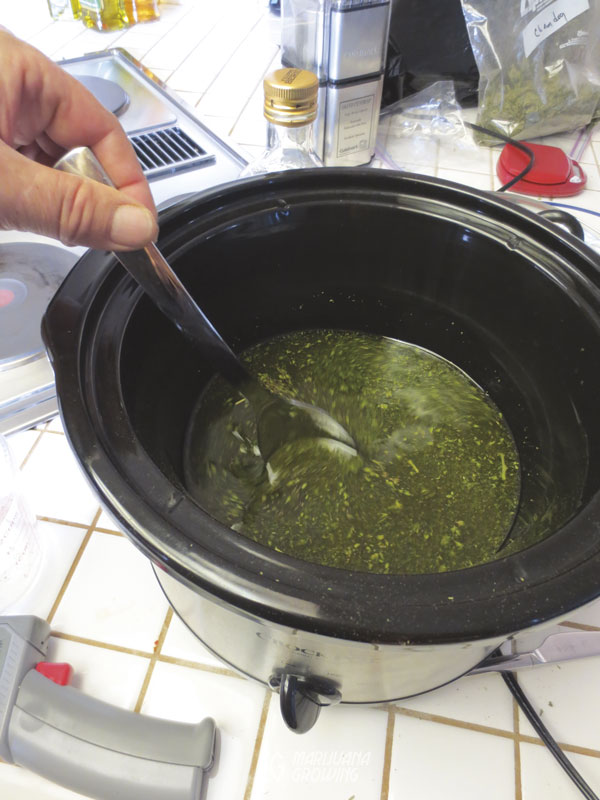
Step Two: Simmer the mix on low heat for 45 minutes and stir regularly.
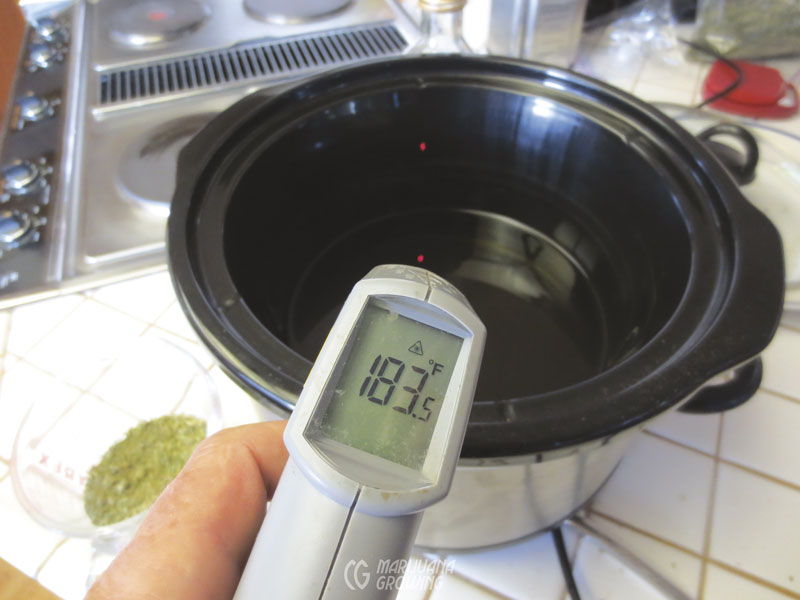
Step Three: Remove from heat and let cool before handling.
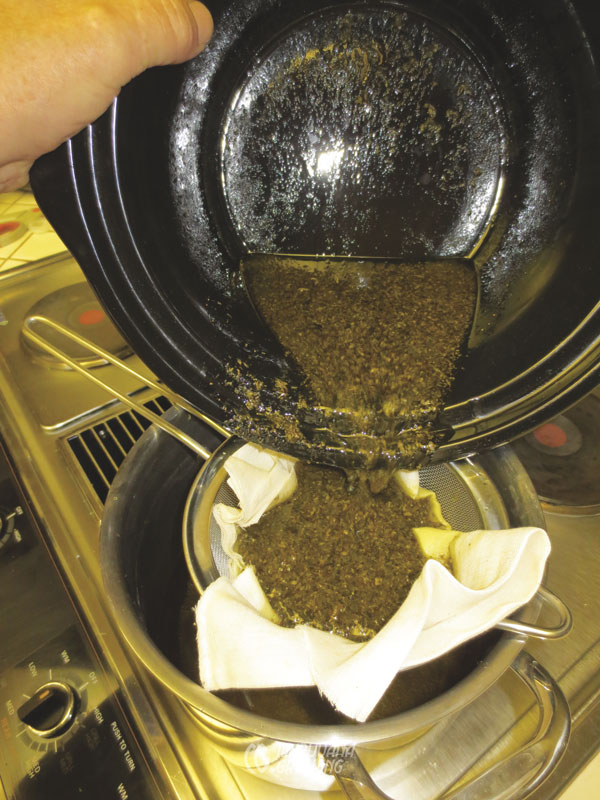
Step Four: Pass mix through a strainer lined with cheesecloth and collect liquid in a receptacle below. Press out residual liquid from cheesecloth using rubber gloves. Compost cheesecloth and cannabis mix.
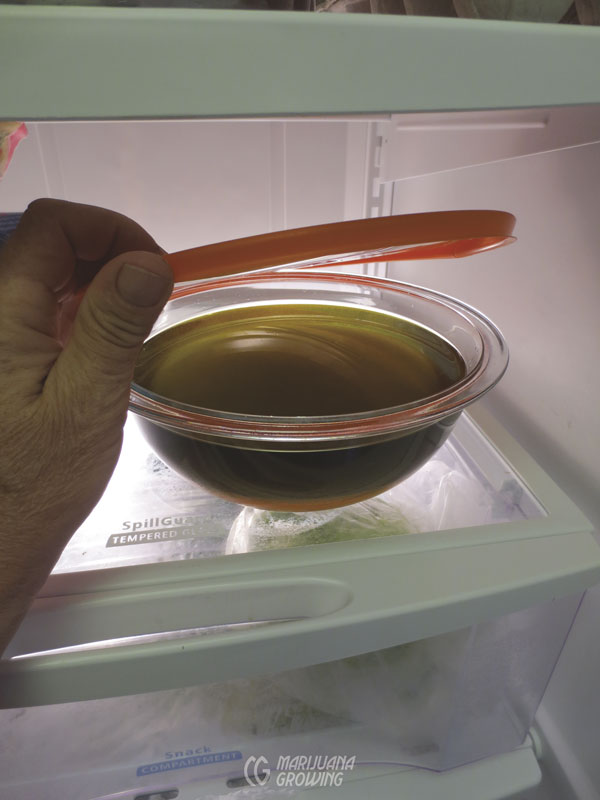
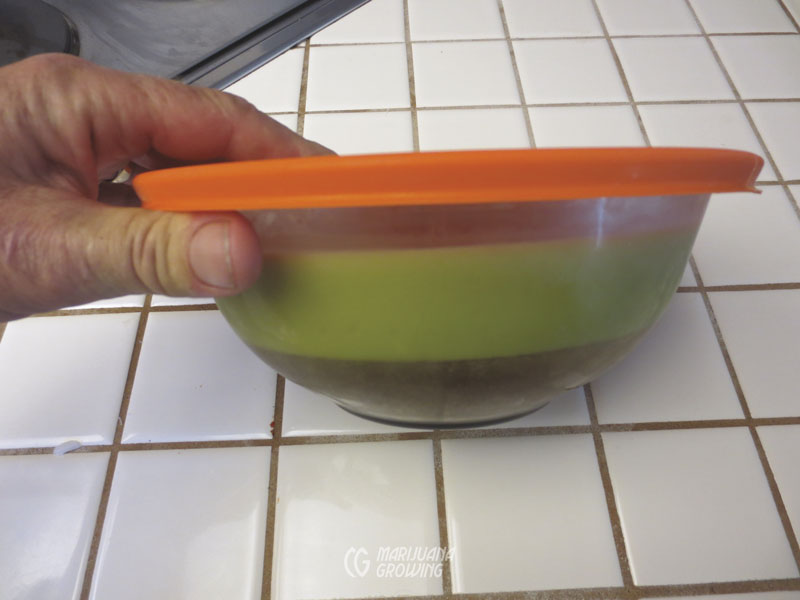
Step Five: Set in the refrigerator over- night to separate out the water.
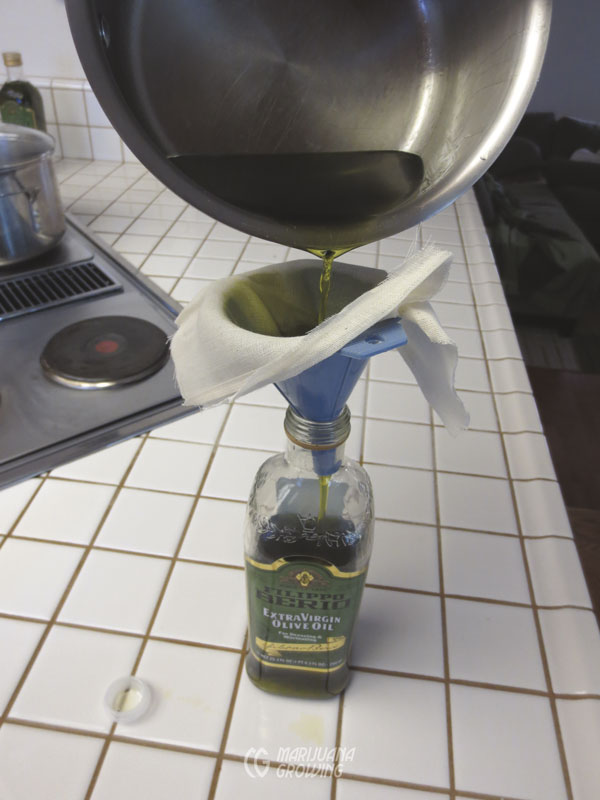
Step Six: Save oil in an airtight container.
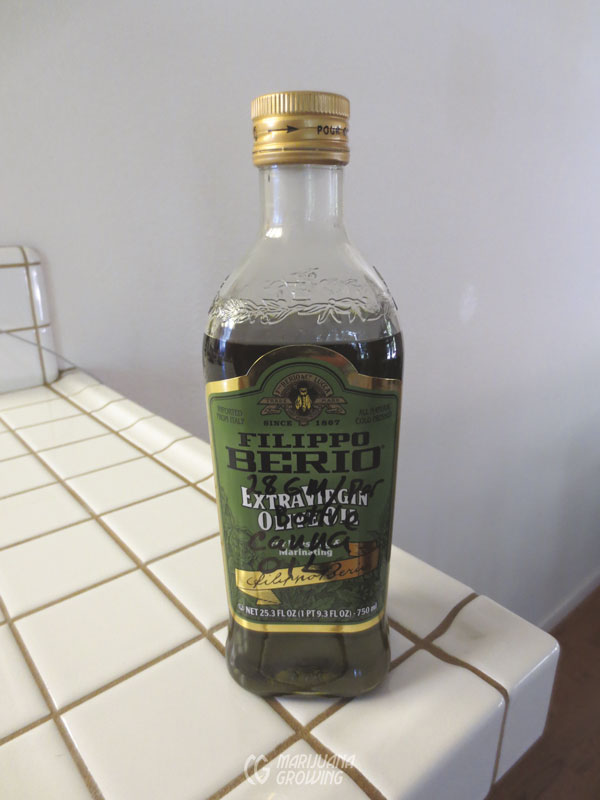
Step Seven: Store in the refrigerator for up to 60 days.
Notes: A pressure cooker can be used to reduce cooking times and extract more cannabinoids, but chlorophyll and other contaminants are also extracted. One half cup of cannabis olive oil is roughly equivalent to one ounce of cannabis.
Raw Cannabis
Dr. William Courtney (http://www.cannabisinternational.org) advises that raw cannabis plants eaten or juiced don’t get anyone high. The CBD overpowers the THC. Dr. Courtney believes raw cannabis eaten or juiced prevents more diseases than any other food available. A growing number of doctors are taking notice. For a complete description on YouTube, see http://www.youtube.com/watch?v=qa0nLdVJiIg.
Utensils
wheatgrass juice extractor
Ingredients
raw cannabis leaves
Juicing Raw Cannabis
Raw cannabis leaves are fed into a juicer, and deep-green cannabis juice trickles out of a nipple while the bulk of the processed leaf is expelled from another outlet.
Juice 15 to 20 cannabis leaves. Juice a carrot or two. Mix 10 parts carrot juice to 1 part cannabis juice. The sweet carrot juice will cut the bitter taste of the cannabis juice.
The juice will keep in the refrigerator for about 3 days, but it is best to consume during the first day. Drink in 3 to 4 servings throughout the day. Keep refrigerated.
Avoid using stems and large, damaged, or discolored leaves. Upper foliage and flower buds make the most concentrated juice.
Cannabis (Hemp) Seeds
In spirits, hemp seeds are used to flavor beer, cider, wine, liquors, and other spirits. Toasted cannabis (hemp) seeds instill creamy, earthy, and nutty characteristics in ales. Normally they are soaked in the mix and strained out, however some spirits leave them to swim around in the bottom of bottles. Little is known about the nutritional value of alcohol-marinated seeds. Hemp seeds contain easily digested proteins, essential fats (omega-3 and omega-6), gamma linolenic acid (GLA), antioxidants, amino acids, fiber, iron, zinc, carotene, phospholipids, phytosterols, vitamin B1, vitamin B2, vitamin B6, vitamin D, vitamin E, chlorophyll, calcium, magnesium, sulfur, copper, potassium, phosphorus, and enzymes. All amino acids essential to optimum health are found in hemp seeds, including the rarely found gamma linolenic acid.
The recommended minimum daily intake of shelled hemp seeds is 4 heaping tablespoons (42 gm). Larger individuals or those suffering with chronic health conditions such as arthritis, high blood pressure, high cholesterol, cardiovascular disease, acne, eczema, psoriasis, diabetes, circulation problems, intestinal problems, constipation, obesity, or prostate problems (to name a few) may want to consider taking 5 to 6 heaping tablespoons (55 gm) per day.
Hemp seeds contain approximately 25 percent protein, 31 percent fat (in the form of nutritious hemp oil), and 34 percent carbohydrates (mostly from fiber), in addition to an excellent array of vitamins and minerals.
Hemp Flour
Hemp flour is typically sold at health food stores and on the Internet. It is milled from hemp seeds. Hemp flour is an alternative to wheat and corn flour. It is rich in omega-3, omega-6, vitamins B and E, calcium, potassium, and fiber. It is also completely gluten-free. Make sure to keep hemp flour refrigerated after opening, because it contains no preservatives.
Hemp Milk
Hemp milk or hemp seed milk is made from hemp seeds. The seeds are soaked in water and ground into creamy milk with a nutty flavor. Health and fitness stores may stock hemp milk, and you can also find it via the Internet.
Cannabis (hemp) seeds contain virtually no THC. The seeds hold a 3:1 ratio of omega-6 and omega-3 essential fatty acids, plus magnesium, phytosterols, ascorbic acid, beta-carotene, calcium, fiber, iron, potassium, phosphorus, riboflavin, niacin, and thiamin. Hemp milk is easy to digest and contains 10 essential amino acids.
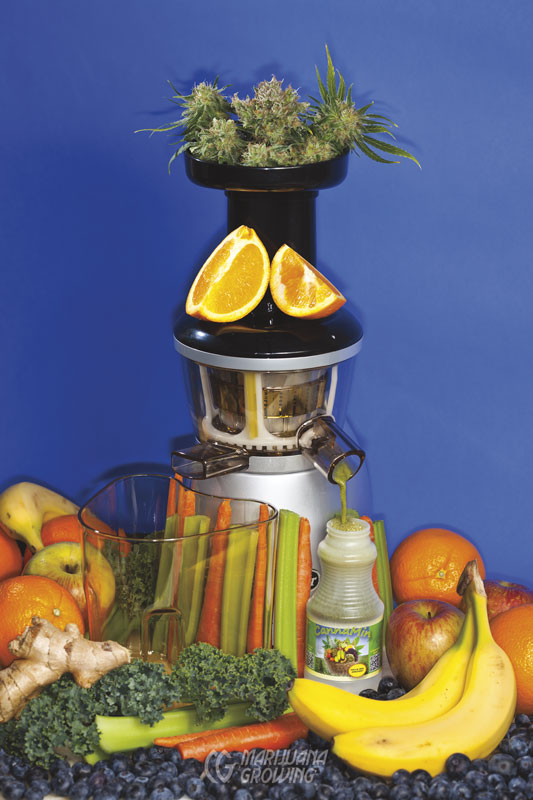
Cannabis buds and leaves are fed into the hopper of this high-quality juicer.
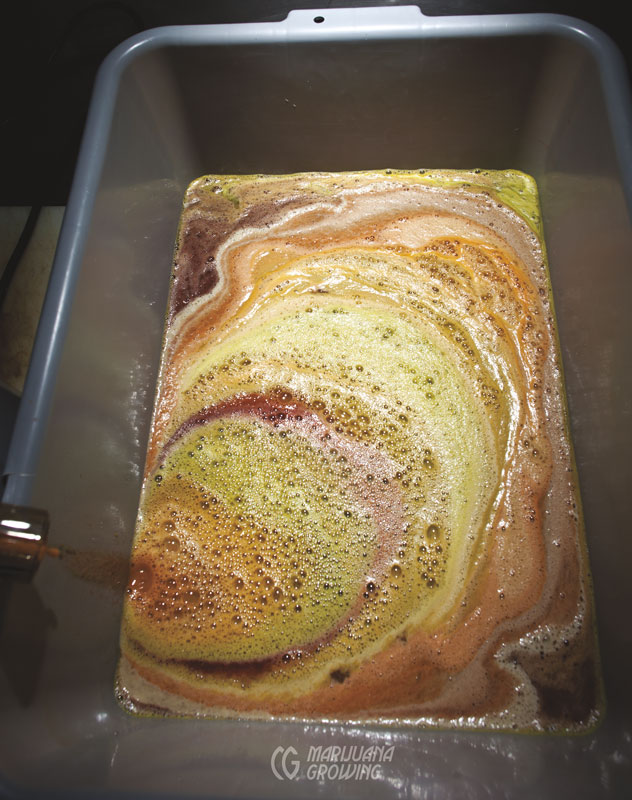
Various vegetables are juiced and the juices blended together.
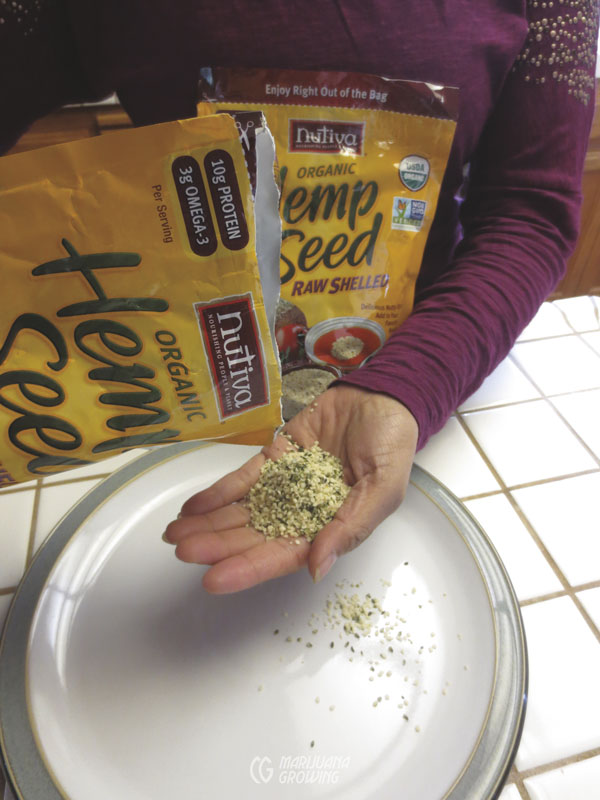
Cannabis seeds contain all the essential amino acids (EAAs) and are rich in essential fatty acids (EFAs), mainly omega-3 and omega-6. Cannabis seeds are also high in magnesium and have the maximum levels of digestible and absorbable globulin protein.
Hemp Oil
Hemp oil or hempseed oil is made by pressing hempseeds. Cold-pressed, unrefined hemp oil is dark to light-green or clear in color, with a nutty flavor. Darker colored oils have a green, hempy taste. THC and cannabinoid content in seeds is miniscule. Hempseed oil has no psychedelic effects.
Hempseed oil has a three-to-one ratio of omega-6 to omega-3 essential fatty acids—in perfect balance with the human body. The clear, colorless oil is also used for body care products, lubricants, paints, inks, and biofuel.
Do not confuse hempseed oil with hash oil, Rick Simpson Oil (RSO, also known as Phoenix Tears). Hash oil is used for both medicinal and recreational purposes and is made from the mature female flowers and leaves of the drug cannabis, thus having a much higher THC content. Hash oil should not be confused with hemp, as the modern usage of the word hemp is reserved for plants that meet the legal requirement of containing 0.3 percent THC or less.
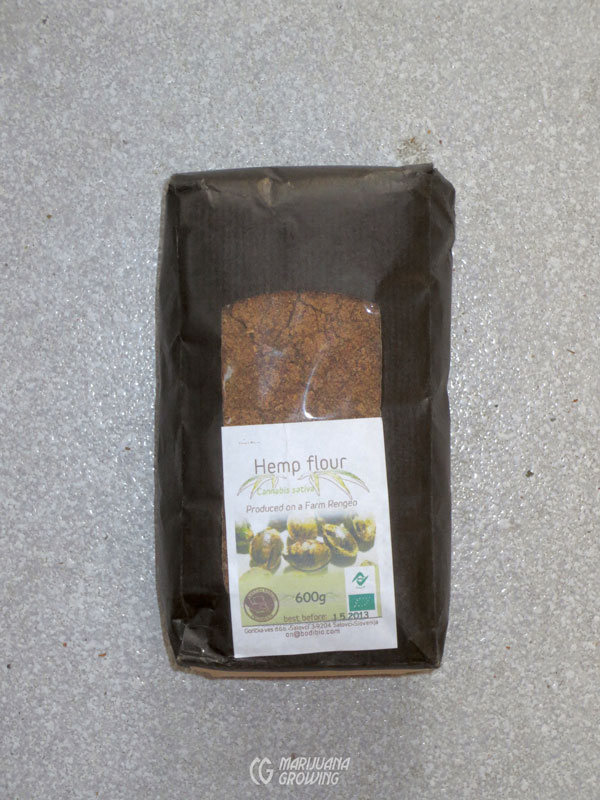
This 2.2-pound (1 kg) package of hemp flour was produced on Farm Renego in Slovenia.
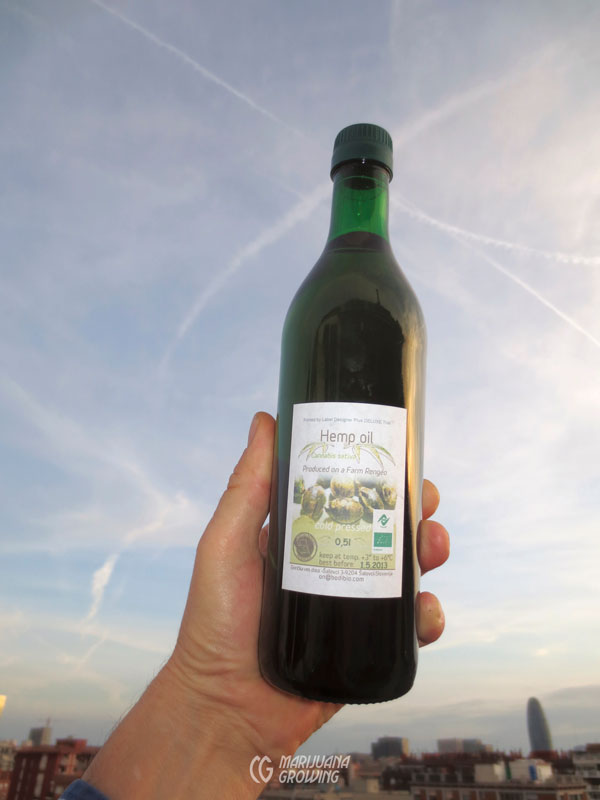
This 16.9 ounce (0.5 L) bottle of hempseed oil was produced on Farm Renego in Slovenia.
Storage
Store cannabis butters and oils in the refrigerator. Cannabis tinctures do not need refrigeration, but it does not hurt them.
Store dry cannabis in a cool, dry, dark location. Sunlight, heat, and air are the biggest enemies of stored cannabis. Store larger amounts of cannabis in airtight containers. Keep airtight packages in cool, dry, dark surroundings.
Recipes
Cannabis Brownies
Utensils
- large mixing bowl
- wooden mixing spoon
- 9 × 13-inch (22.9 × 33 cm)
baking pan - measuring cup
- measuring spoons
- wire cooling rack
Ingredients
• 4 oz (28.3 gm; 4 squares) unsweetened chocolate
• 0.75 c (17.7 cl) cannabis butter (recipe, page 562)
• 2 c (47.3 cl) white (granulated) sugar Ingredients
• 4 oz (28.3 gm; 4 squares) unsweetened chocolate
• 0.75 c (17.7 cl) cannabis butter (recipe, page 562)
• 2 c (47.3 cl) white (granulated) sugar
Directions
Step One: Preheat oven to 350oF (176.7oC)
Step Two: In a saucepan on low heat, melt chocolate and cannabis butter. Stir the mix as it melts in the pan.
Step Three: When the mix has melted and combined, slowly stir in sugar. Next, add eggs one at a time while blending into the mix. Add vanilla. Stir in flour and chopped walnuts. Mix until batter is consistent.
Step Four: Spread the batter in a greased 9 × 13-inch (22.9 × 33 cm) baking pan.
Step Five: Bake in preheated oven for 35 minutes at 350oF (176.7oC). Remove from the oven, let cool, and consume!
Cannabis Cookies (Biscotti)
Utensils
- large mixing bowl
- wooden mixing spoon
- cookie sheets
- measuring cup
- measuring spoons
- wire cooling rack
Ingredients
- 0.25 lb (113.4 gm) cannabis butter (recipe, page 562)
- 0.5 c (11.8 cl) white (granulated) sugar
- 0.5 c (11.8 cl) brown sugar
- 2 eggs
- 1 tsp (4.9 ml) vanilla extract
- 2 c (47.3 cl) unbleached all-purpose flour
- 1 tsp (4.9 ml) baking powder
- 0.5 tsp (2.5 ml) salt
- 3 c (71 cl) quick-cooking oats
- 0.5 c (11.8 cl) chocolate chips

Cannabis brownies are easy to make and very popular among medical cannabis patients. Brownies became famous in North America during the 1960s when it seemed that everybody started making them. Of course, grandma always made the best brownies!
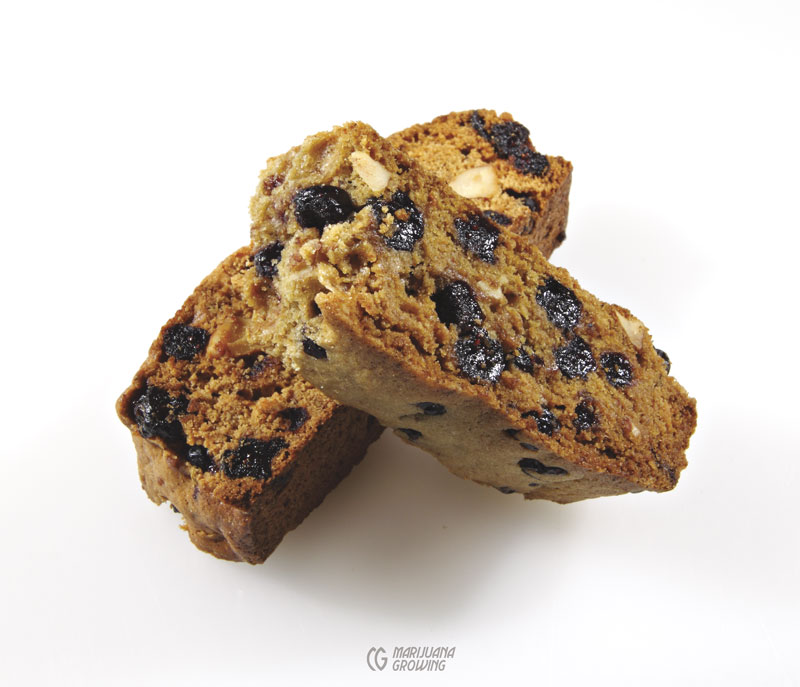
Cannabis chocolate chip biscotti
Step One: Cream butter and sugar in a large bowl. Beat in eggs separately, and stir in vanilla. Stir in flour, baking powder, and salt. Stir in oats and chocolate chips, mixing to a consistent dough. Cover and chill for 1 hour or more.
Step Two: Preheat oven to 350oF (176.7oC). Grease cookie sheets. Form dough into balls about the size of a walnut, and set on 2-inch centers on the cookie sheets. Use the back of a spoon to flatten each ball a little.
Step Three: Bake for 10 to 12 minutes (8 to 10 minutes if you like chewy cookies). Let cookies cool for 5 to 10 minutes on cookie sheets or transfer to a wire cooling rack for faster cooling.
Cannabis Lollipops
Utensils
- Parchment paper or tinfoil or small ice-cube tray or candy mold (Lollipop molds are available at most large stores with a cooking section.)
- Cooking spray (nonstick)
- Candy thermometer
- Cooking pot
- Stirring spoon
- Measuring spoon
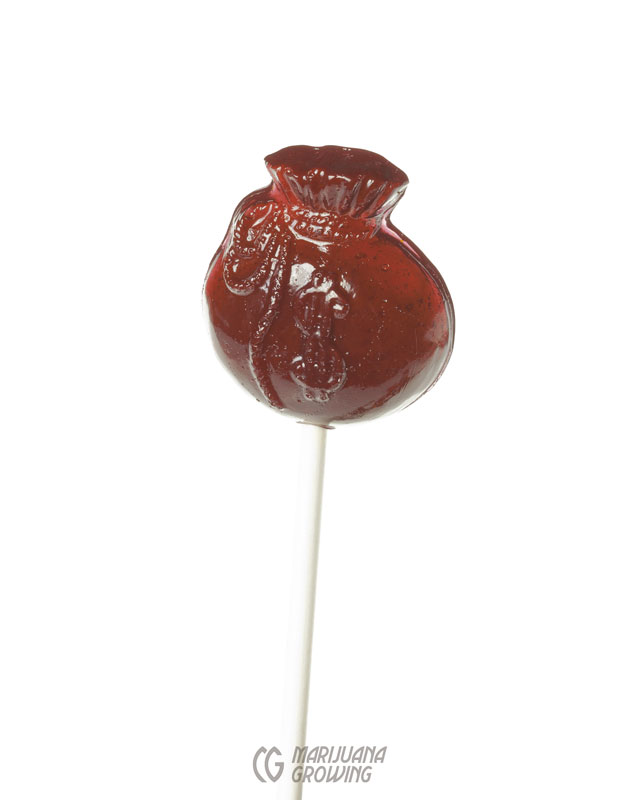
Cannabis lollipop!
Ingredients
- 0.25 c cannabis butter (recipe, page 562)
- 2 c (47 cl) white (granulated) sugar
- 0.66 c (15.6 cl) corn syrup
- 0.25 c cannabis butter (recipe, page 562)
- 2 c (47 cl) white (granulated) sugar
- 0.66 c (15.6 cl) corn syrup
Step One: Prepare your molds by spraying them with nonstick cooking spray. Insert lollipop sticks into the molds.
Step Two: Melt cannabis butter in a heavy-bottomed pot over medium heat. Slowly stir in sugar.
Step Three: Add syrup and stir the mixture thoroughly. Stop stirring when it is well blended and starts to boil.
Step Four: Hang candy thermometer on the side of the pot. Be careful! The pot and mixture are very hot!
Step Five: The blended mixture will continue to boil and will ultimately reach 275oF (135oC).
Step Six: Remove from heat and add flavored Jell-O mix. Stir thoroughly. The flavor and color of the Jell-O determine the flavor and color of the lollipops.
Step Seven: Spoon the mix into the mold cavities and make sure to cover the back of the stick. Or set lollipop sticks out on nonstick parchment paper or tinfoil and cover the end of each stick with one tablespoon (1.5 cl) of mix. The candy mix is heavy and forms a circle around the stick.
Step Eight: As they cool to room temperature, lollipops harden. Wrap separately in plastic wrap or consume! Refrigerate wrapped lollipops for up to a month. Makes about 12 lollipops.
Cookbooks
Here is a short list of some of my favorite cookbooks. They are chock-full of recipes and everything you need to know to combine the concentrated cannabis butter, oil, milk, etc. into flavorful dishes.
Here is a list of some of my favorite cookbooks, which cover a wide range of culinary styles and preferences:
- The Joy of Cooking: This indispensable classic cookbook explains everything about cooking.
- The Fannie Farmer Cookbook: This basic American cookbook has nearly 2,000 recipes.
- The Official High Times Cannabis Cookbook: A must-have for all cannabis cooking enthusiasts.
- Betty Crocker Cookbook: 1500 Recipes for the Way You Cook Today: A classic cookbook with a wide variety of recipes.
- The Cook’s Illustrated Cookbook: 2,000 Recipes from 20 Years of America’s Most Trusted Cooking Magazine: Offers amazing instructions for preparing great meals.
- Jerusalem: A Cookbook: Featuring diverse Muslim, Jewish, and Christian recipes.
- The Everything Gluten-Free Cookbook: A valuable resource for those with celiac disease or gluten/wheat allergies.
You can check our website forum “Cooking with Cannabis” at www.marijuanagrowing.com for more cookbook information and recipes.
Cannabis Beverages
Cannabis Beer
Countless beer recipes can easily incorporate cannabis. This short section will discuss cannabis preparation and when to add it to the brew. Hemp, low-cannabinoid cannabis, can be added to the brew for flavoring. Medicinal cannabis is to be added to beer to impart flavor and/or meter out cannabinoid-rich beer.
Raw cannabis often lends an unpleasant taste to beers, which has made marketing difficult. Avoid the “hempy” taste by using kief, hashish, or oil that does not contain foliage residue. Soak cannabis in cold, low-EC water for 3 to 4 hours to remove water-soluble chlorophyll and tars responsible for the “green” flavor. This will help purge the hempy taste.
Shake water off and dry cold-water-washed cannabis to the point that it crumbles into a powder before adding it to the brew. Contain ground cannabis in a nylon stocking or similar “tea bag” found at beer brewing stores. Add approximately 0.17 to 0.7 ounces (4.81–19.8 gm) of leaves per 3 ounces (8.9 cl) of finished beer.
Ales and beers can be any style: pilsner, porter, cream, stout, and so on. Strong-flavored brews work best to mask the cannabis taste. Cannabis is put into beer brews when hops are added. Some of the alcohol- or oil-soluble cannabinoids dissolve into the mix as it ferments.
A few hemp beers include Greenleaf (Germany), Hanfblüte (Switzerland), Humboldt Hemp Ale (USA), Liquid Hemp (Austria), and Nirvana (Holland).
Note: Cannabis and hops (Humulus lupulus) are both from the Cannabinaceae family, but hops grafted to cannabis rootstock does not produce cannabinoids.
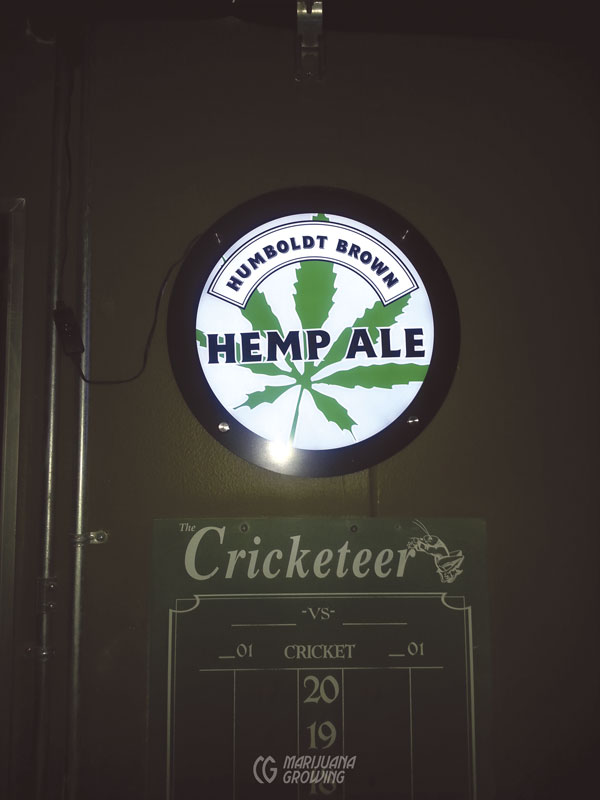
Hemp is used to flavor ale. Cannabis concentrate can also be added for extra effect!
Cannabis Drinks
Several companies in the USA and other countries have launched carbonated and concentrated cannabis drinks. Concentrated cannabis syrup is added to different products after the heating process so as to not destroy the active cannabinoid ingredients. The list of new cannabis products is growing rapidly.
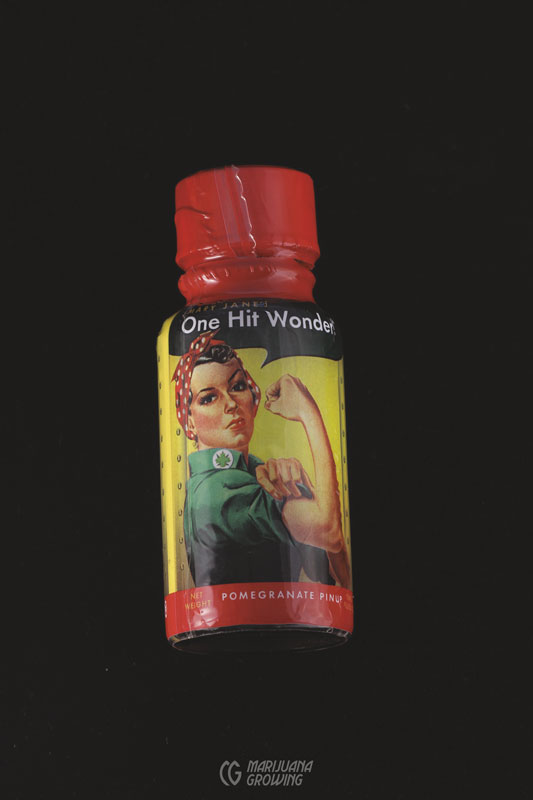
Pomegranate-flavored cannabis drink (MF)
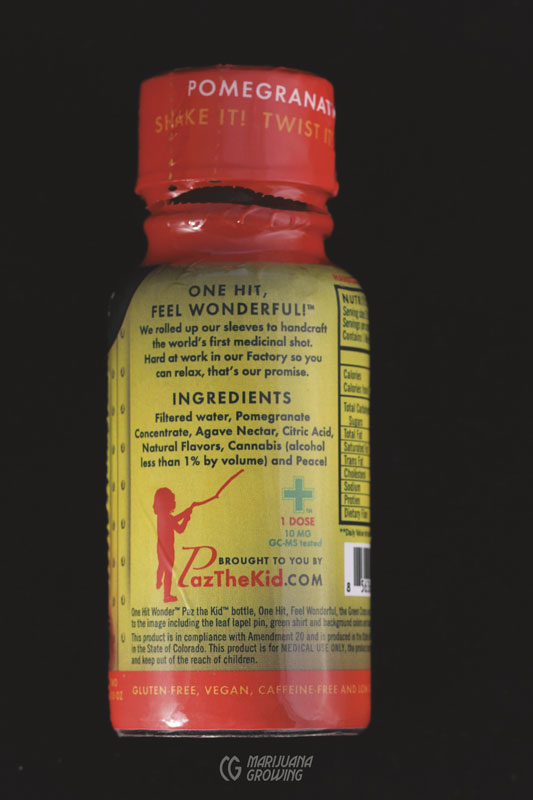
Los ingredientes en esta bebida incluyen cannabis (con menos del 1% de alcohol por volumen). (MF)
Cannabis Wine
“Cannabis wine is becoming popular in the wine country of California. In fact, I believe it is the only original style of wine created in the New World,” said Crane Carter, president of Napa Valley Marijuana Growers, and later added, “Cabernet sauvignon from the Stag’s Leap district is thought to pair particularly well with pot.”
Cannabis wine delivers cannabinoids more quickly than baked foods, and the combination of alcohol and cannabis produces a different effect.
To make cannabis wine, add 0.05 to 0.1 ounce (1.5–3 gm) of cannabis per bottle (75 cl) of fermenting wine. Cannabinoids are extracted as part of the alcohol fermentation process, but to date little is known about the efficacy of cannabinoids extracted thus. Nonetheless, high-quality cannabis produces more cannabinoid-potent wine. Aging cannabinoid wine for nine or more months before bottling ensures the maximum amount of cannabinoids will be extracted. Aging also mellows cannabis flavor.
Many cannabis wines and spirit drinks are available in Austria, Germany, Holland, and Switzerland. The scope of this chapter is to introduce subjects and stimulate thought. Please consult our website, www.marijuanagrowing.com, to learn more about cannabis wine.
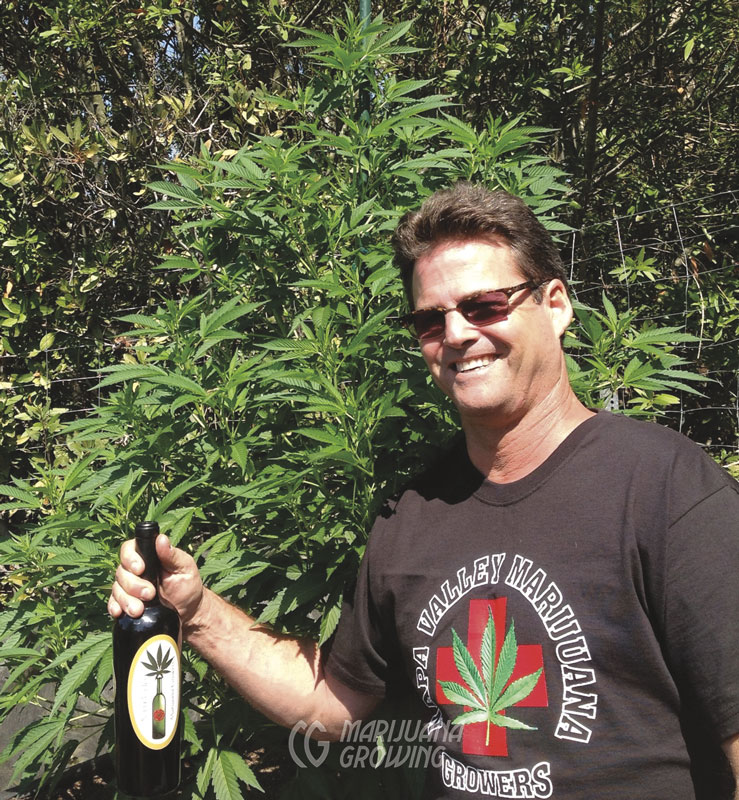
Crane Carter, de Napa Valley Marijuana Growers, sostiene una de sus botellas de vino de cannabis.

